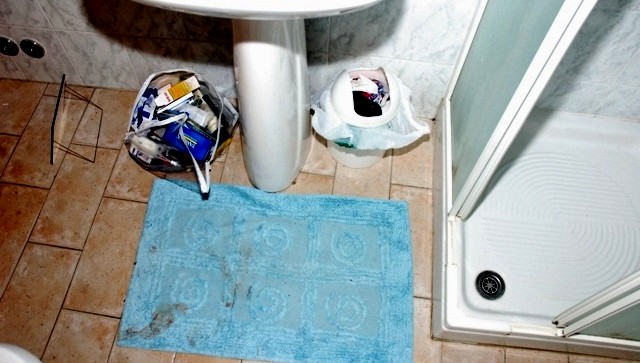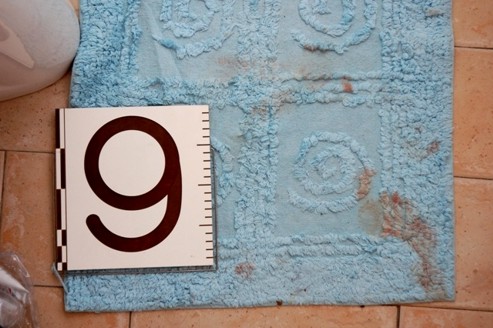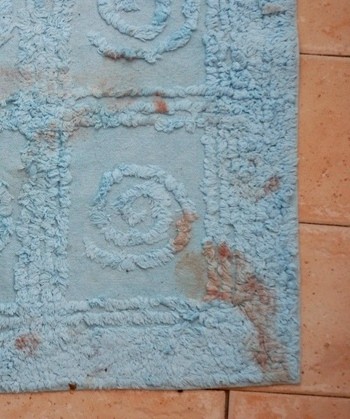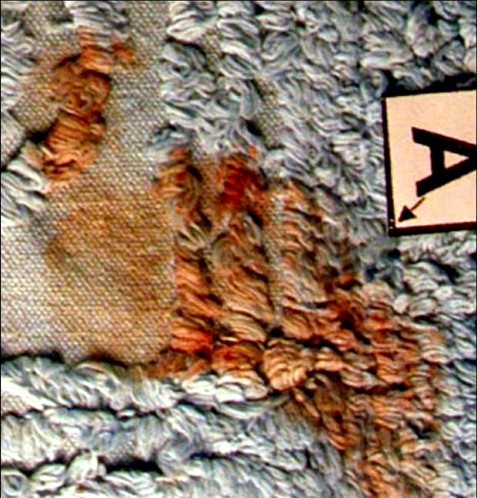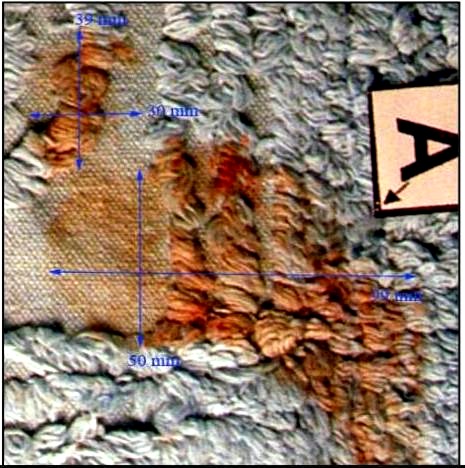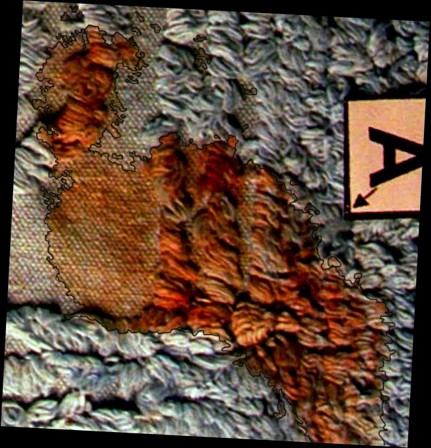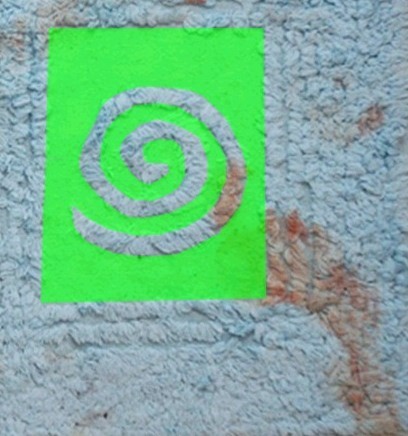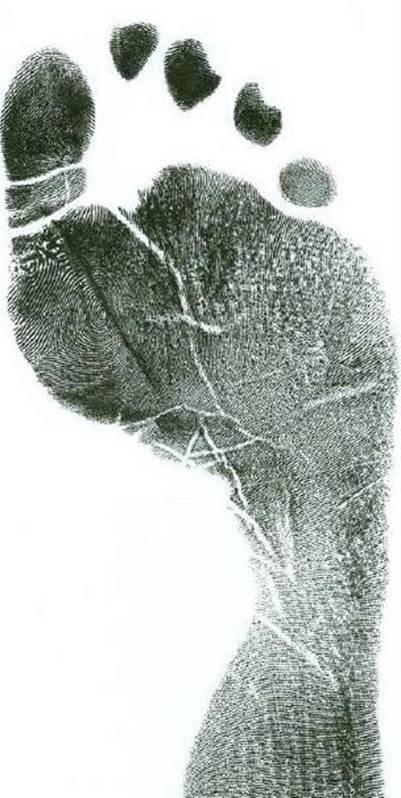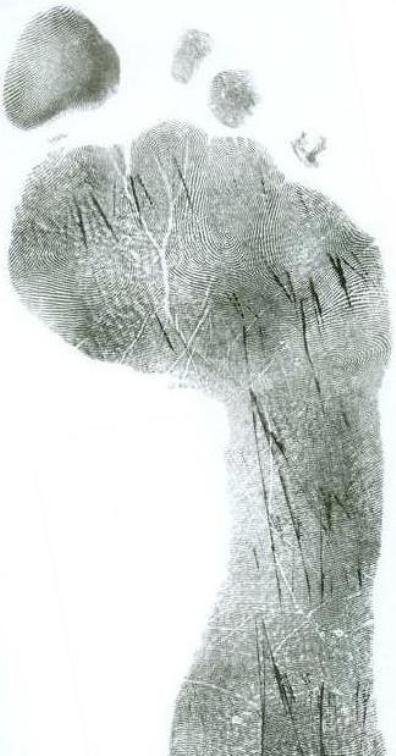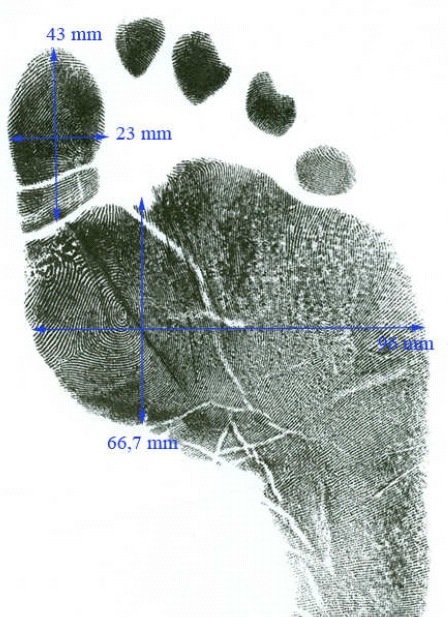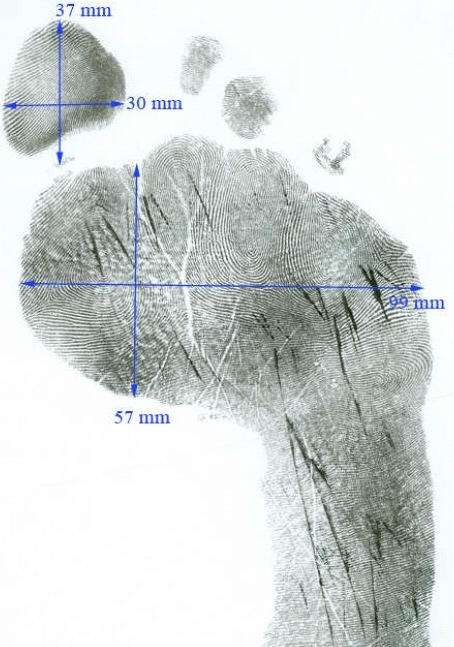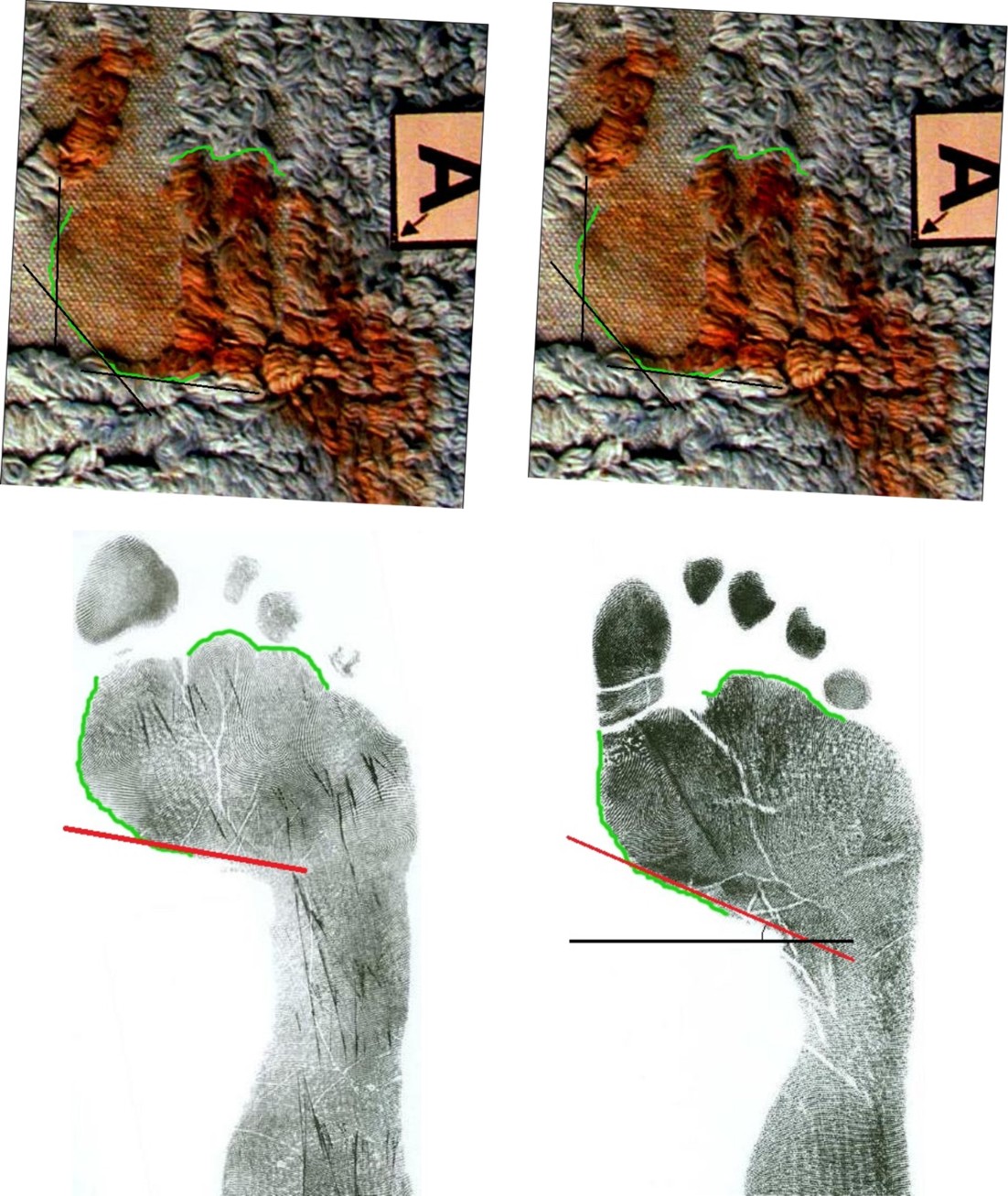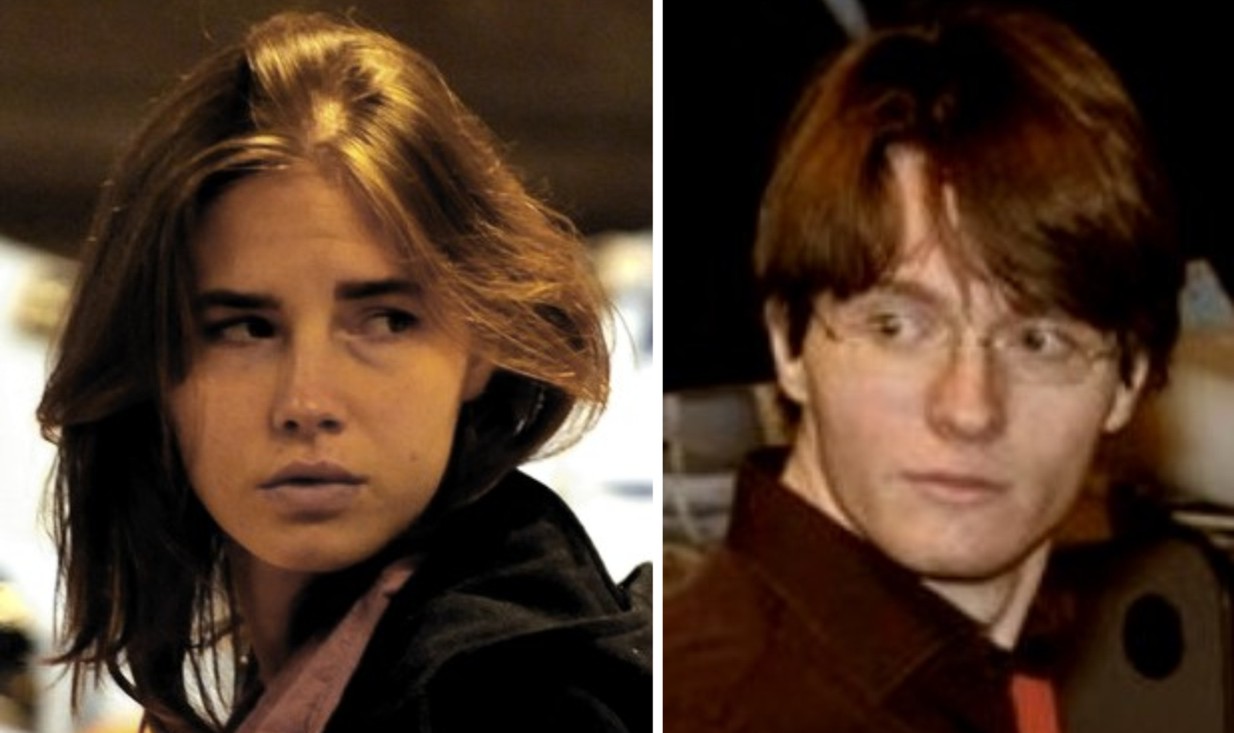
Category: 27 Single alibi hoax
Wednesday, April 16, 2014
The Incriminating Bathroom Evidence: Visual Analysis shows the Footprint IS Sollecito’s
Posted by Machiavelli
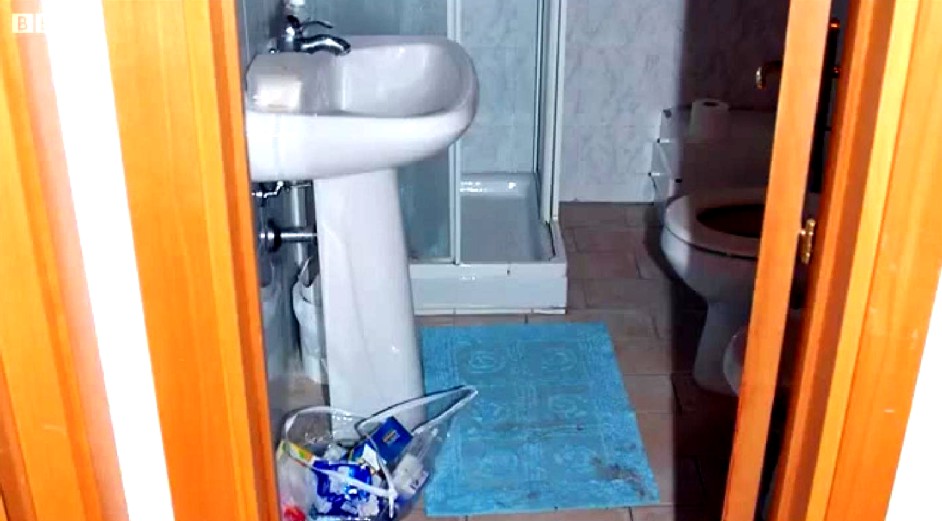
[Please click on each image for a larger and more high-resolution version]
The sheer depth and width of the hard evidence
The defenses really don’t want you to know this: in both width and depth, the full panoply of the evidence against Knox and Sollecito is absolutely overwhelming.
As we remarked in our post below there are far more and far stronger evidence points than UK and US courts normally require for conviction. But only the trial panel of judges observed anything like their full array.
The 2010 Massei Trial Report (which the Nencini Appeal court validated this past January) is a SUMMARY of what was presented to the judges in the courtroom. Those presentations in court were in turn something of a SUMMARY of the hard evidence buried in all the evidence files and the minds of witnesses.
Italian media SUMMARISED for Italians what was to be seen in the courtroom and to be read in the Massei Report. They were barely able to do even summaries for the 1/4 of all the trial hearings that were not open to the media or the public.
UK and US media for the most part didn’t even bother to provide comprehensive summaries (the very fine on-the-spot reportings of Andrea Vogt, Barbie Nadeau and Ann Wise were the main exceptions).
So in effect people in the UK and US attempting to follow the story didnt for the most part receive even a summary of a summary of a summary!
Not one US or UK newspaper or TV network translated the Micheli Report, or the vital Massei Report, or the Supreme Court appeal, or the Supreme Court outcome - only the (mostly professional) translators on PMF dot Org did all that translation.
This post is another example of how far down - beyond even Massei - it’s possible to drill into the evidence, and see it still hold up.
Some past posts on TJMK drilled down to similar depths, on the knives, on the DNA, on the mixed-blood traces, on the phone-events, on the motives and psychologies, and so on. All that evidence too all held up.
Visual analysis of the bathroom-mat footprint
This post mainly consists of high-resolution pictures and measurements. Presented like this, the pictures and measurements largely speak for themselves, and show the real strength of the bathroom-mat footprint evidence.
You will see that as SomeAlibi previously concluded using other methods, this footprint was quite undeniably Sollecito’s. It bears no similarity at all to Rudy Guede’s.
Please click on all images for larger versions in scalable PDF format
1 . [Below] the bathmat and the print, with measurement reference
2 . The bathmat print and the surrounding area
3 . The bathmat print (photo from Polizia Scientifica).
4 . The bathmat print, with vertical and horizontal sizes, from Rinaldi’s report
5. The bathmat print, photo with enhanced contrast.
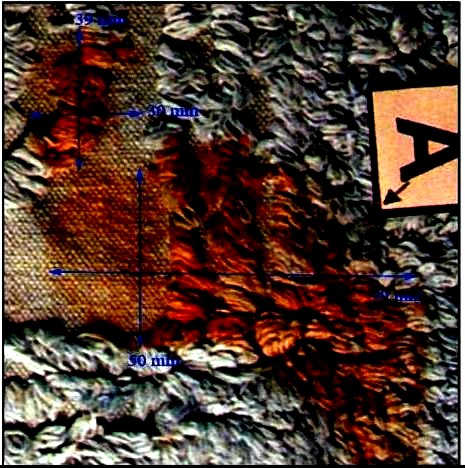
The photo above was modified by highly enhancing contrast.
6 . Enhanced contrast helps to spot some features
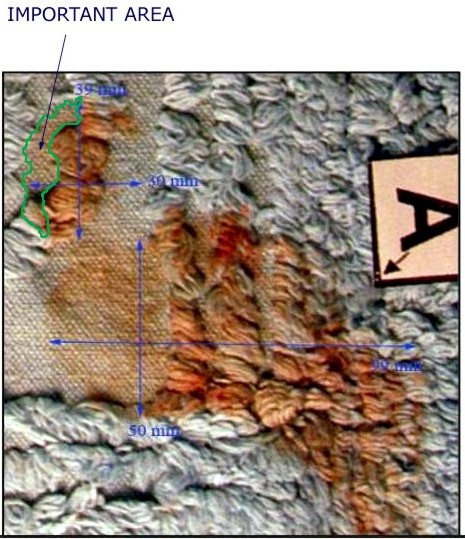
Contrast may help to highlight especially some parts of the print outline.
For example the area on the left labeled as “important area” in the picture (which was “forgotten” in the notorious photo elaborations disseminated by the ‘Friends of Amanda’ group), shows the actual left outline of the “˜big toe’ of the bathmat print.
The toe includes the area indicated in this picture (here the picture is shown again in its original colours).
7. The bathmat, with enhanced contrast
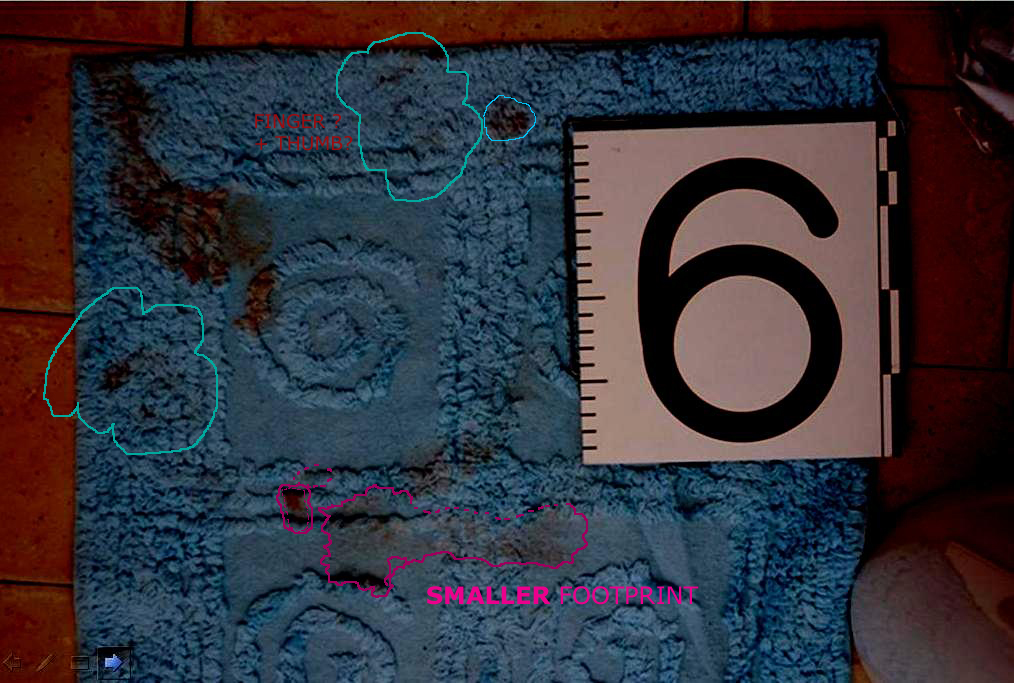
The contrasted image is showing the presence of other stains
There are other stains on the carpet (about another 10, factually situated in one half of the mat area), and also there shows a second diluted footprint (apparently from a foot of smaller size).
8. The selection of a set of red colour shades, outlined by an automatic outline generator
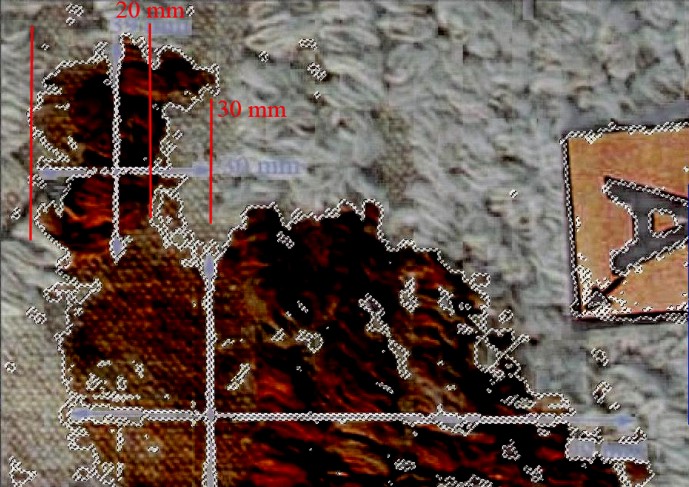
Shows the shape and the possible “˜outline’ of the stain
Reference measurements indicate the width of the “˜big toe’ in millimetres.
9 . A hand drawing of the outline (detail).
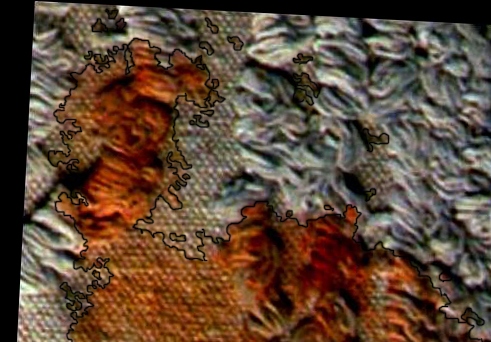
The photography above was modified
The modifications are: +28% contrast, -8% luminosity, + 20% colour saturation, from the original.
An outline has been drawn manually on the photoshop image, trying to be as faithful as possible to the actual stain.
You can notice that, apart from some minor “˜disputable’ very faint areas (such as the area between the toe and the metatarsus) there are only minimal differences between an automatically generated outline and a manually drawn one.
The shapes of the “˜big toe’ are extremely similar in both contours (images 8 and 9), in fact all meaningful features are basically identical.
We consider this manually drawn outline as good for comparison.
10 . The complete hand-drawn outline
11 . Minor detail: small dots separated from the main stain
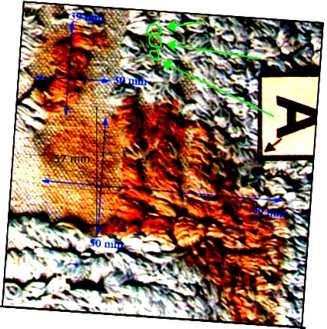
Observe the small red ‘dots’ in the picture above
Although we can’t draw any conclusion about their possible significance, we note the existence of these very small “˜spots’ of a faint red colour shade, separated from the big stain.
They are detected by the computer generated outline above, and that we also see as distinguishable with the naked eye thus we considered them in drawing manually the outline.
We don’t draw any conclusion about them; but because of their sensitive position (they may suggest a “˜small toe’ mark) we take note of them.
The green arrows in the picture point out their position (green circles).
12 . An image in electronically modified colours
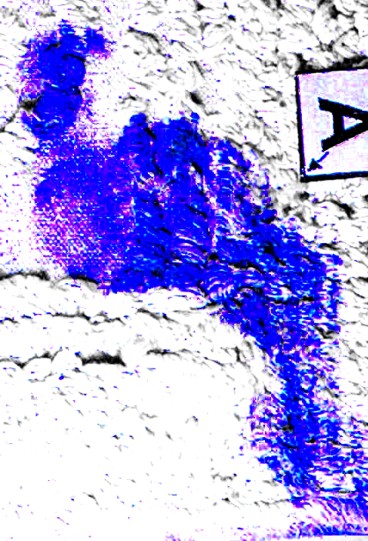
Distribution and intensity of the colouration
As a part of the preliminary study of the stain, we also produced this image above where the computer assigned an artificial colour to an array of shades of ‘red’, thus allowing to further isolate the stain from the background for further assessments about its shape.
This picture shows the distribution and intensity of the colouration. (note: the existence of some above mentioned tiny marks is recorded by this technique too)
13 . The bathmat has a spiral-shaped relief decoration
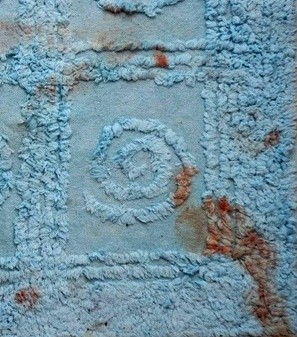
The footprint’s toe obviously balancing on top of the relief decoration.
We think the outline of the “˜toe’ mark of the bloody footprint is affected by the shape of the decoration, in particular the missing part of the toe on the right side, which is remarkably coincident with the margin of the decoration.
So that on that side there is a striking correspondence between the outline of the “˜negative area’ ““ the fabric surface around the spiral, which is lower ““ and the big toe’s outline
This indicates that the outline of that mark on that side was affected by the decoration margin, thus the print there has a “˜missing part’. So the “˜crooked’ bloody area in fact follows the margin of a larger toe.
Because of such coincidence, we can logically assume that the actual shape of the big toe mark appears to be part of a big toe, with larger surface which left its print only partly because part of its surface did not have contact with the fabric, in correspondence of the “˜negative area’.
14. The “negative area”
15. Mat decoration in relief and the toe mark
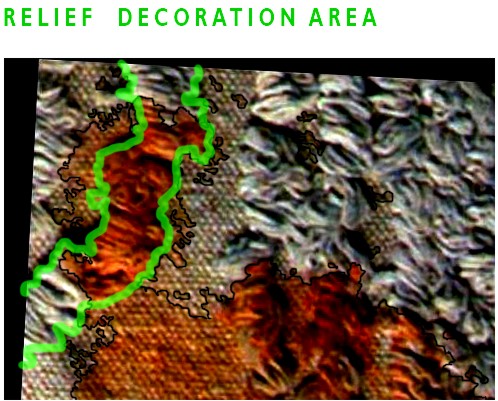
Observe above one single, unitary stain
The remarkable coincidence between the outlines of the decoration in relief and of the toe mark is shown in the picture above.
The rough contour of the print obtained through a smooth curve highlights the shape of the big toe.
Part of the relief decoration outline coincides with the toe mark outline, which shows, highlights and explains how all parts of the red toe mark, that you can see left of the relief decoration, they all belong to one single, unitary stain.
Thus we can deduce that the “missing” area on the right of the toe is determined by the decoration, and coincides with the negative area.
16. Picture (by Kermit) showing a rough shape of the stain
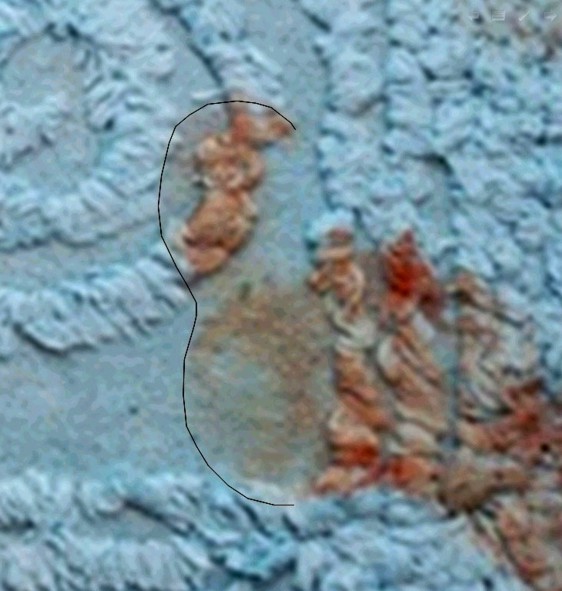
Observe shape, curvature and size
This drawing by Kermit above highlights the rough shape, curvature of left margin and overall size of the big toe.
17. Rudy Guede’s sample print
A copy of this picture together with one of Sollecito’s print at the same scale will be used for comparisons.
18 . Raffaele Sollecito’s sample print
A copy of this picture together with one of Guede’s print at the same scale will be used for comparisons.
19. Part of Rudy Guede’s sample print with Rinaldi’s reference measurements
20. Part of Sollecito’s sample print, with Rinaldi’s reference measurements:
21. Bringing all photographs down to the same scale
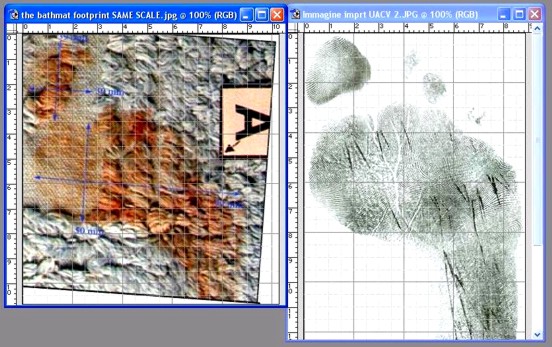
An accurate exercise of scaling was done
This was based on Rinaldi’s referenced pictures. Each one of the Rinaldi’s sample pictures has multiple measurements on several points of reference which allow a high precision determination of their scale and sizes, and thus comparison at the same scale.
In order to further increase scaling precision, the scale was calculated previously and separately for each comparative measurement in the three photos; this was done multiple times for each measurement and the average was picked in order to reduce error as for statistical measurement method.
The resulting final error in the scale is extremely small, far below a threshold of significance that could affect comparison (which was set arbitrarily at 1%, but it’s probably significantly higher, while the actual error is much lower).
In other words, the scale error that may affect your screen pictures will be definitely smaller than any possible perceivable (either significant or tolerated) difference that would be noticed or that may affect the attribution of the stain, when this is compared to the sample.
22. The hand drawn outline is shown again here
23 . The outline (matched scale) overlapped on Sollecito’s sample footprint
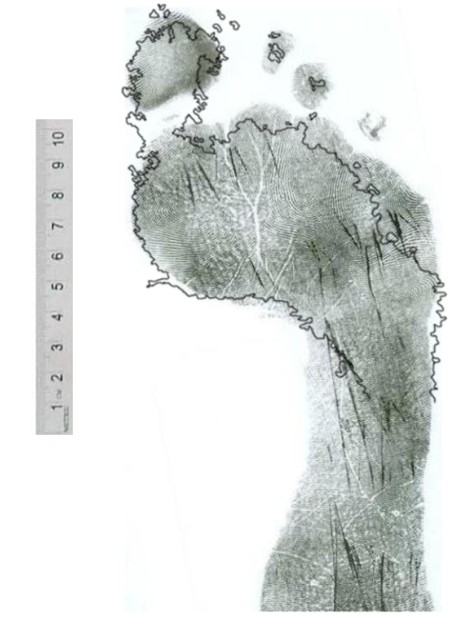
The array of compatibilities with Sollecito
The bathmat stain does not seem to have major incompatibilities with Sollecito’s print; it shows rather an array of compatibilities that can be perceived visually.
One interesting feature is the shape, size and position of a ‘big toe’, that appears as a remarkable coincidence; the toe also has a kind of cleft (see 28 below) on the curvature of its left margin. Another outstanding coincidence is the curvature of the plantar arch on the left.
24 . The same outline overlapped on Guede’s footprint
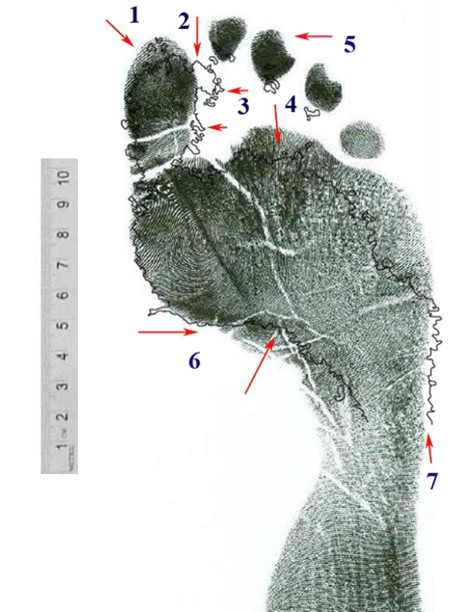
Compare with Guede’s - matched scale.
If you look at the overlapping of the stain outline (see pic 22.) with the sample of Guede’s print (see pics 17. 19.), you may notice 7 major differences, showing a failure of compatibility. Those differences are indicated by numbers (1-7) in the picture .
Each one indicates an area of major difference between the outline of the bathmat stain and the outline of Guede’s sample print. Those measurement differences are remarkably larger than those that can be detected on the overlapping with Sollecito’s sample print.
On the other hand, the compatibility between Sollecito’s print and some very peculiar aspects of the bathmat print (such as a 30mm wide and short toe) were absolutely remarkable.
The differences between the bathmat stain and Guede’s print are :
1) Toe mark of stain is significantly SHORTER than the big toe in Guede’s sample print (a difference of about 7 millimetres). Some people may want to attempt an objection, by suggesting that such a difference may be just a consequence of the position chosen for the overlapping, that maybe the bathmat print was just positioned too low in the picture, the problem may be solved by shifting it up about 7 millimeters so as to make the tip of the bathmat toe ‘coincide’ with the tip of Guede’s print toe.
However, such objection wouldn’t work; it’s a wrong argument. In fact the only possibly correct position for overlapping the bathmat stain outline is determined by the left curvature of the ball of feet and plantar arch (the area of the picture near number 6), which is by the way the most clearly outlined part of the bathmat stain. If you shift the bathmat stain upwards, the outline will miss the match with the curvature of the left margin of the ball of the feet. You will notice that the plantar arch in this area is already very incompatible with Guede’s plantar arch. It tends to become even more incompatible the more you shift the bathmat stain outline towards the toe.
The problem has no solution, since the more you shift the stain outline upwards (in the direction of the toe) in an attempt to make it look more ‘compatible’ with the length of Guede’s toe (or with an upper margin) the more it will become incompatible with the plantar arch. In order to limit the incompatibility of the plantar arch, and in order to keep an overlapping of at least the left margin of the ball of the feet, you need to place it as shown in the picture, this is the position of ‘maximum’ compatibility between the bathmat stain and Guede’s print. Conclusion: the bathmat toe is too short.
2) Toe mark of stain is TOO WIDE (30 mm). It is much wider (30 mm) than Guede’s toe. The number 2. indicates the protruding mark at the upper right, the mark which Giulia Bongiorno desperately insisted on calling a “second toe” mark. In fact, not only would the mark miss completely any hypothetical Guede’s ‘second toe’ in any possible position of the print; also you may notice (highlighted by pics 8. and 9.) how it is not a “mark” itself, but actually it just part of the same area which is entirely continuous in shape and coloration with the rest of the toe mark, and - the most remarkable feature - its right outline is coincident with the outline of the spiral-shaped relief decoration, so that you can reasonably conclude that it is determined by that (the missing area at the lower right of the ‘big toe’ is determined by the existence of the “negative area” of the bathmat decoration).
Conclusion: the bathmat stain has a wider toe mark, however one likes to call it (“big toe”, or “big toe + second toe”) that fails to match any possible part of Guede’s print. The bathmat print is clearly different and incompatible with Guede’s print. It simply cannot be overlapped to any part of Guede’s sample print. Such area is a very significant difference that points outright to incompatibility between the stain and Guede’s print.
3) The toe mark is larger also in the area located at the lower portion of the toe. The toe of the bathmat print in fact has a ‘right margin’ which actually has some additional small marks, small drops protruding towards the right, like droplets maybe produced by the wet cotton fibres of the part in relief which protrude towards the right. This tends to suggest the toe area of the stain may in fact be considered wider: the object that produced it was definitely wider than 22mm, in this area of the toe as well. So also a look at this area confirms that the bathmat stain is wider than 22-23 mm (more towards 30 mm) not just when measured at the upper corner (number 2.) but also at its “lower” parts; here, the small marks caused by the liquid suggest that a larger surface has squeezed liquid from some fabric threads leaving some trace also on the lower area.
4) Bigger incompatibility of Guede on the metatarsus front outline. This area is the front outline of metatarsus: the stain is almost 1cm shorter than Guede’s metatarsus. This happens when you chose the overlapping so as to make the left outline and plantar arch (6.) of metatarsus coincide, as in the picture. Sollecito’s sample print also shows some difference from the stain in this area (pic. 23.) but the difference between the stain and Sollecito’s print is significantly smaller than what you can see in Guede’s print.
5) There are NO SMALL TOES in the bathmat stain. Small toes are completely absent from the bathmat stain (while the tiny blood marks around the stain don’t coincide with their expected position if it was Guede’s print). Such lack of small toes is a peculiarity of the bathmat print. This is a remarkable difference from Guede’s print, and at the same time, a considerable analogy with Sollecito’s print. In fact one outstanding feature of Guede’s print is the evidence that Guede places a big load of weight on his small toes while instead Sollecito has a posture with a weight distribution with the contrary tendency, and obviously he almost does not touch the ground with his small toes.
Thus, Guede’s small toes are all very well pressed on the ground and thus, we can reasonably infer they are somehow naturally likely to get wet if he steps on any wet surface, and anyway they should get wet for sure if the foot is immersed in water or washed (the foot that left the bathmat print must have been immersed in bloody water). The murderer supposedly washed his foot then stepped on the bathmat. In order to attribute the print to Guede we should assume that Guede “forgot” to touch the carpet with his small toes (while instead he puts a lot of weight on them) or that he managed to not rinse them.
6) The outline of the stain has a PLANTAR ARCH that COINCIDES, by curvature and angle, with the plantar arch in Sollecito’s print, while instead it is very different from the plantar arch of Guede’s print.
7) The stain is larger than Guede’s print metatarsus as visible in the right area of the stain. The difference is rather significant, almost half a centimetre, that is bigger than the difference with Sollecito’s print which instead coincides for a trait. This difference cannot be “solved” in any way since, even if one wanted to claim that the scale is wrong and that the stain should be sized down, this would make the toe, already too short (as in 1.) become even shorter.
If instead the toe length is adjusted the metatarsus becomes even less compatible with Guede. We recall that Massei found that Guede’s feet had a print overall more slender than Sollecito’s.
25 . Other features:
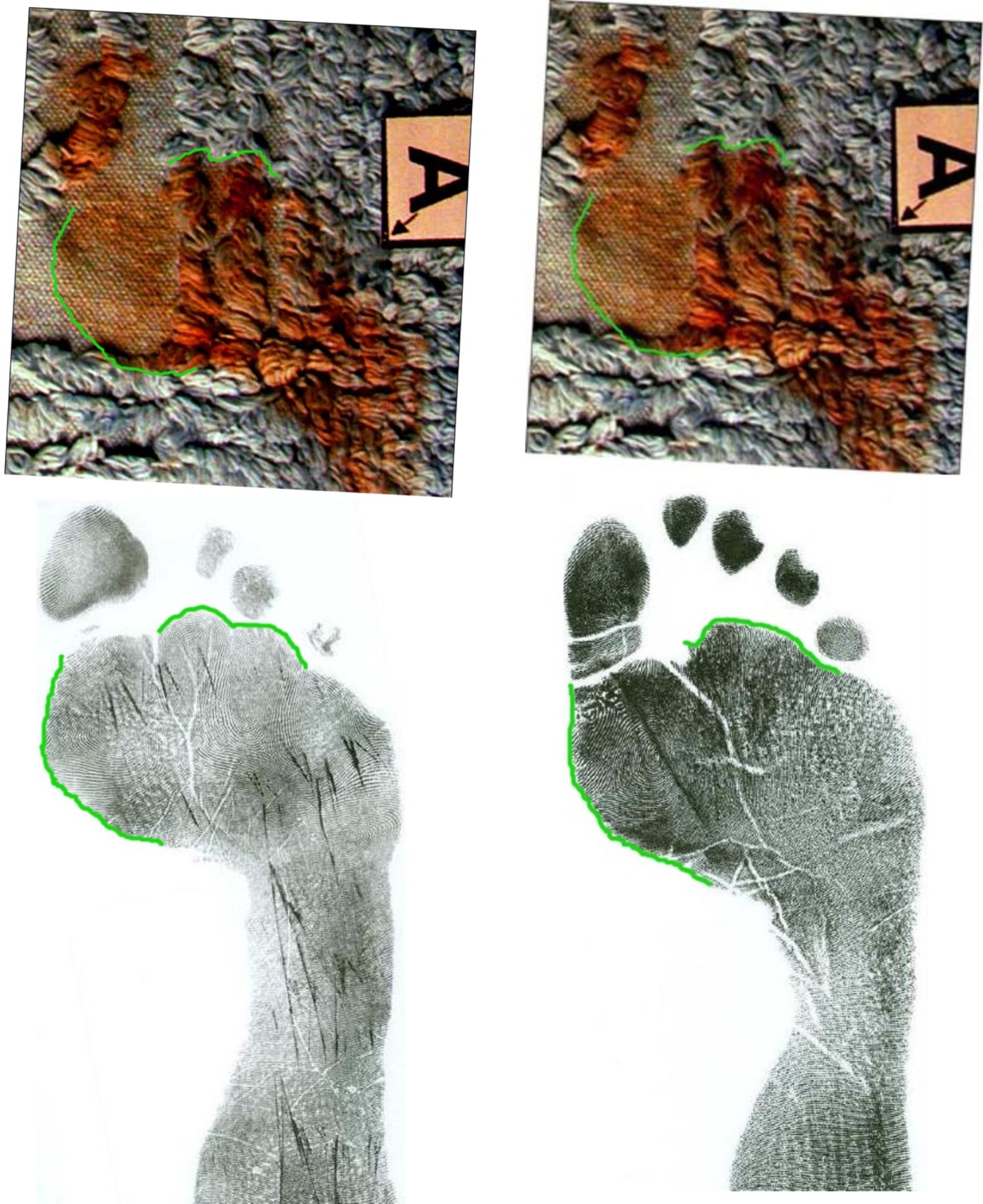
Curvatures of plantar arch are very different
The plantar arch curvature, highlighted in two different drawings (the second highlights also the upper outline “hunches”); the plantar arches in the two sample prints of Sollecito and Guede are shown below. The curvatures of plantar arch are very different.
26. The outline curvature generates different angles
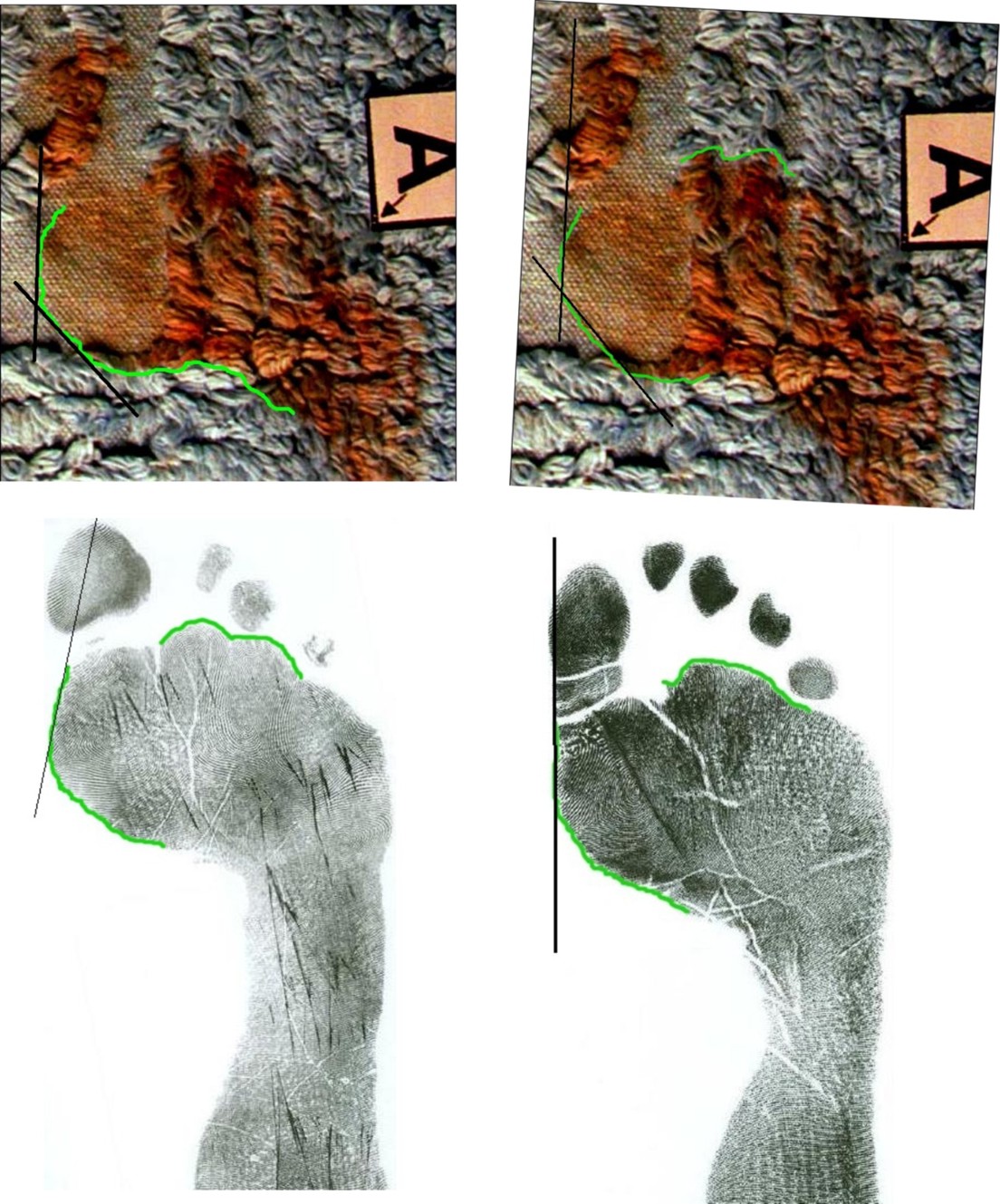
Sollecito’s and Guede’s plantar arch curvatures have very different angles. Also the left outline of metatarsus maintains a different curvature. Sollecito’s outline has an angle (see outline tangent) intersecting the toe (the metatarsus has a “bunion”); in Guede’s print there is basically no intersection, the outline and the toe form almost a straight line.
27 . Plantar arch curvature angle differs between Sollecito and Guede
If you consider the vertical axis of the sample footprint, and its orthogonal line, you may notice how the plantar arch curvatures of the two prints accomplish different angles: the two angles are VERY different, not just three or four degrees.
The (too) narrow angle of Sollecito’s plantar arch probably has a relation with the protruding outline and angle seen in pic 26., and seems related to a hallux valgus (which Guede does not have).
28 . The “cleft” on the left side of the stain
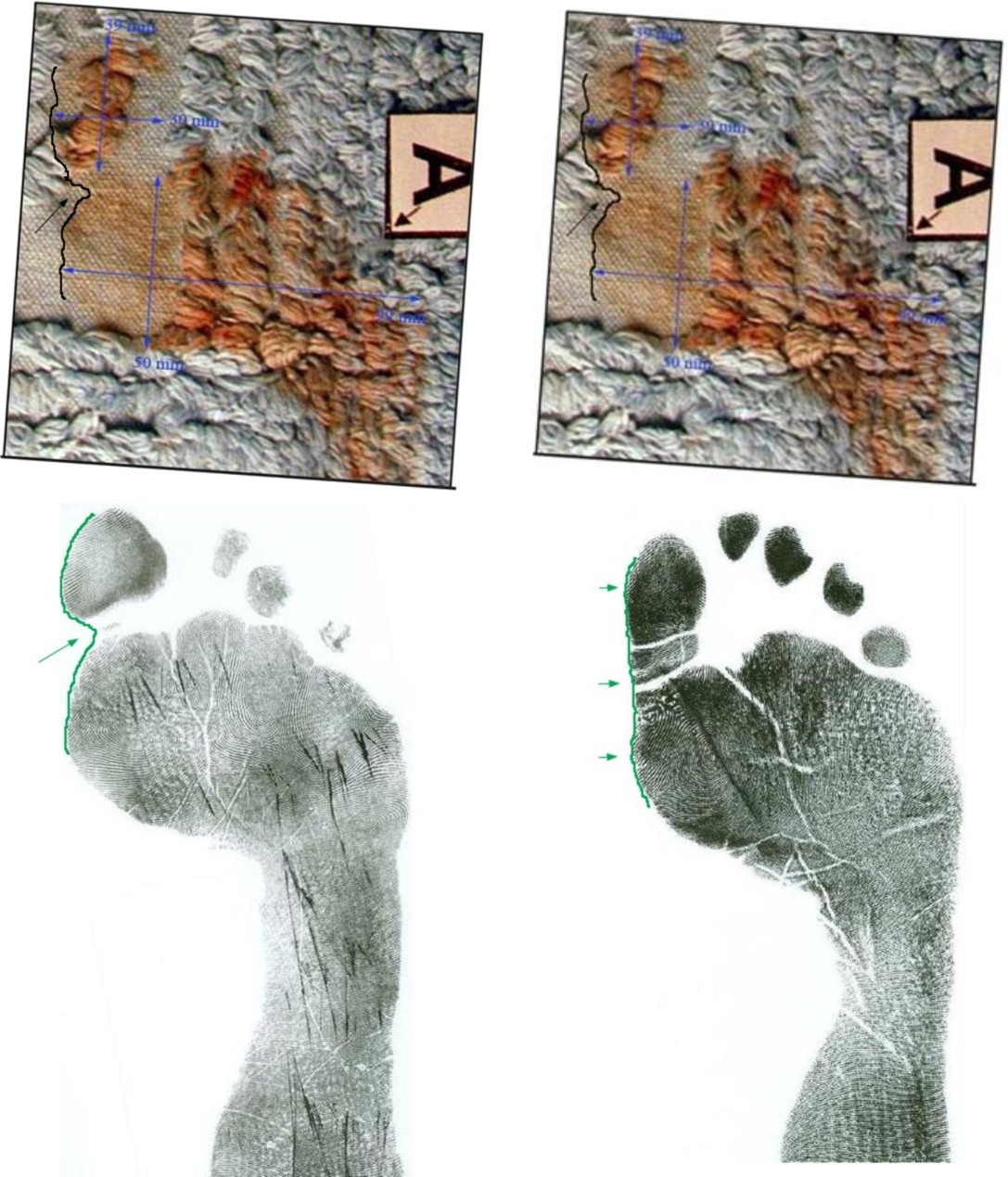
The “cleft” on the left side
This has a correspondence with one sample print, not so with the other.
29 . Table of metric comparison (by SomeAlibi)
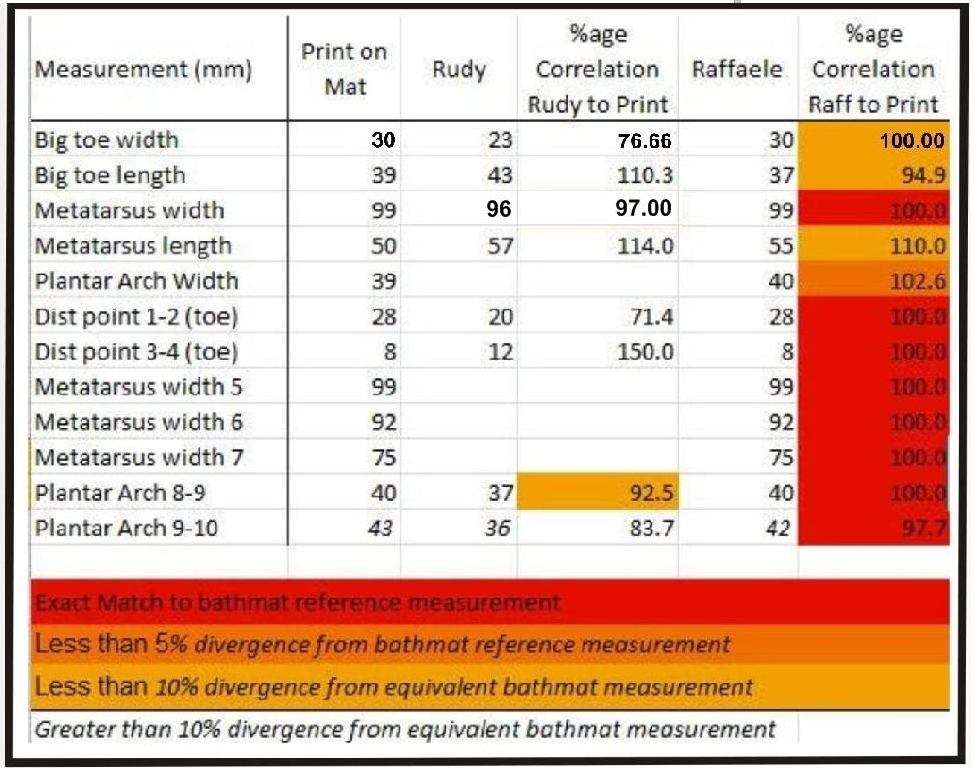
SomeAlibi’s post of a year ago
Comparison of measurements and analysis of correspondence degree of bathmat print, with both Guede’s and Sollecito’s sample prints.
Monday, March 03, 2014
As Knox & Sollecito Try To Separate Themselves, Each Is Digging The Other In Deeper
Posted by willsavive
1. Sollecito Blabs Yet Again
One of an increasingly long list of “gotchas” for the prosecution, flowing from their tendencies to talk way, way too much.
In a recent exclusive interview on an Italian TV news broadcast, Sollecito said he has several “unanswered questions” for his former girlfriend, Amanda Knox.
“You all know that the focus was only through Amanda to her behavior, to her peculiar behaviour, but whatever it is, I’m not guilty for it. “Why do they convict me? Why do put me on the corner and say that I’m guilty just because in their minds I have to be guilty because I was her boyfriend. It doesn’t make any sense to me.”
This adds yet another waiver to the many different explanations Sollecito provided over the years about the same details.
In their “official” story, in the part that remained consistent, Knox and Sollecito both claimed that Knox left his flat the morning after Kercher’s murder and returned home, where she noticed the door left wide open and witnessed blood spots in the bathroom.
Knox claimed that she found it odd and just assumed that one of her roommates was menstruating and left blood behind. She proceeded to take a shower and returned to Sollecito’s flat and ate breakfast.
2. Telling Narrative Change
“Certainly I asked her questions,” Sollecito explained in his latest interview. “Why did she take a shower? Why did she spend so much time there?” When asked what responses he had for these question Sollecito replied, “I don’t have answers.”
In the interview, Sollecito said Knox left his apartment to take a shower, then returned hours later looking “very agitated.”
Yet, in an interview with Kate Mansey on 4 November 2007 just two days after the murder, and two days prior to arrest, Sollecito said:
But when she went into the bathroom she saw spots of blood all over the bath and sink. That’s when she started getting really afraid and ran back to my place because she didn’t want to go into the house alone.
3. RS Differs Sharply From Knox
This is a far cry from what Knox said in her email also dated 4 November 2007 to friends and family, Knox wrote:
I returned to raffael’s place. after we had used the mop to clean up the kitchen i told raffael about what i had seen in the house over breakfast. the strange blood in the bathroom, the door wide open, the shit left in the toilet. he suggested i call one of my roommates, so I called filomena.” (6th paragraph).
The discrepancies between Knox’s version and Sollecito’s version is strikingly different.
- Raffele claims Knox was visibly distraught when she returned and that this was the focus of discussion (i.e. being the first thing they discussed).
- Knox claims that she did not even bring up the bizarre circumstances back at her apartment until “after” they finished mopping the kitchen floor.
4. My Analysis Of The Above
In his latest statement, Sollecito is clearly trying to distance himself from Knox, believing that there is far more evidence against her than against him. But:
- Sollecito forgets to mention the bloody barefoot prints at Knox’s apartment, found to be in Kercher’s blood attributed to him.
- Also the knife found in his apartment that scientists say was the murder weapon.
- Also his DNA found on Meredith Kercher’s bra that was found in her room, even though Sollecito claims that he was never ever in that room.
- Also his own strange behavior, which includes providing a false alibi (saying he and Knox were at a party with a friend on the night of the murder).
Also several conflicting other versions.
But what’s there to question if you [Raffaele] were with Knox the whole day and night of Meredith Kercher’s murder?
It appears as though Sollecito is alluding to the notion that he knows something far more than he is saying; yet, he is being very careful with his words””only providing us with a hint of this.
His latest statement is a clear attempt to distance himself from Knox.
5. Sollecito Freaks Out On Twitter
Sollecito appeared on Twitter recently, for what he claimed was to answer questions and clear his name.
He was very outspoken of his innocence and had no problem in his witty, sarcastic responses to those who questioned his innocence.
However, when I asked him about the Mansey interview he denied claiming that he was with Knox at a friend’s party on the night of the murder [huh?!].
Sollecito disappeared for a couple of days, came back to Twitter writing only in Italian, and ceased responding to any more questions.
Is it possible that Sollecito will turn on Knox altogether at some point when the pressure mounts over the next year? Guess we’ll have to wait and see”¦
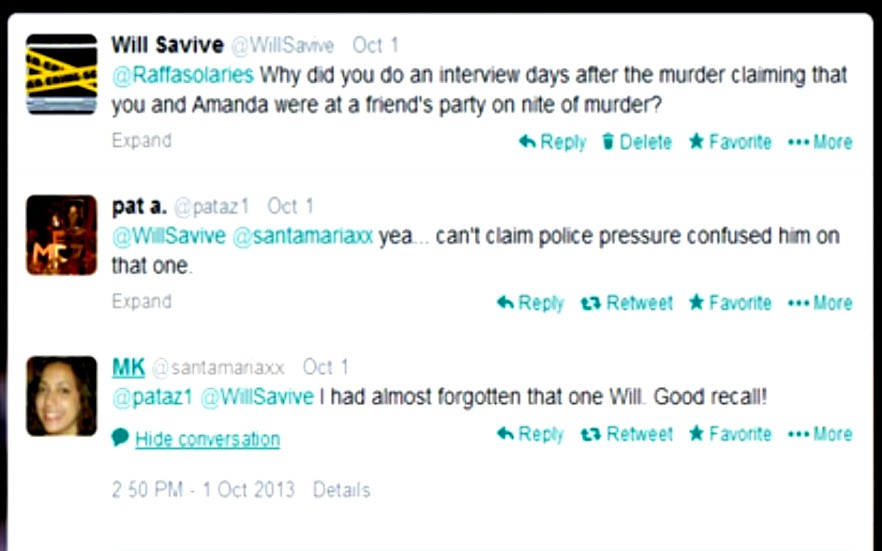
Cross-posted from Savive’s Corner
Friday, February 14, 2014
Hard Questions By Italian Journalist Giuseppe Castellini For Sollecito
Posted by Peter Quennell
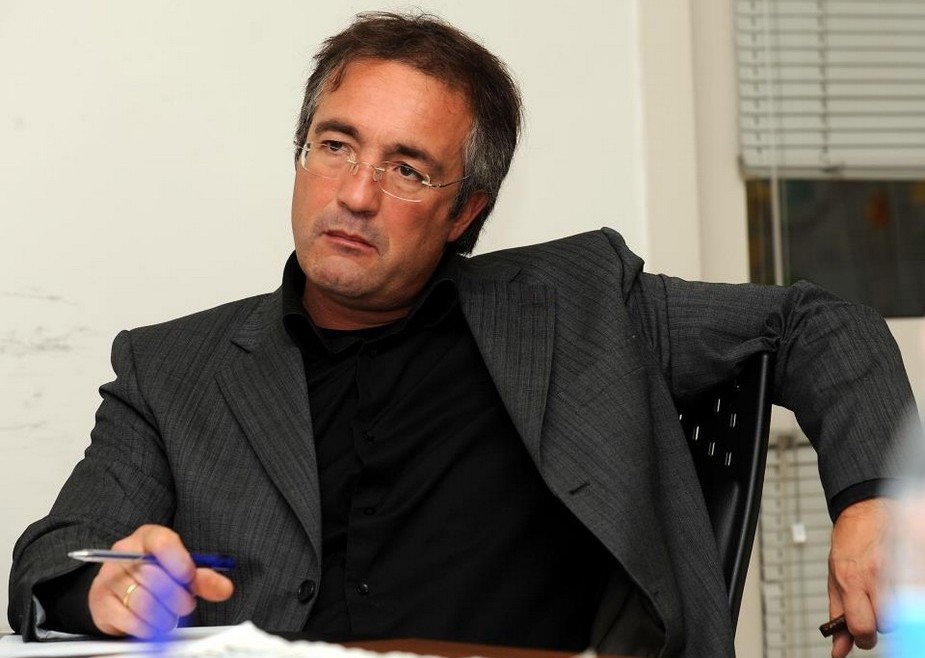
[Above: Giuseppe Castellini of Giornale dell Umbria has long exposed the Knox/Sollecito lies]
1. Overview Of Italian Media Takes
The fast-growing satires of Knox and Sollecito in Italy described in our previous post are not just emerging in a vacuum.
The many tough crime-show comperes and crime reporters in Italy have rarely let Knox or Sollecito get away with any of their lies. One example was when Bruno Vespa, the host of Porta a Porta, Italy’s most popular crime show, forced Francesco Sollecito to admit to Italy that his son lied extensively in Honor Bound. Another example is when Oggi published some of Knox’s lies and they were rapidly exposed. For seemingly endorsing Knox’s lies Oggi will face trial for obstruction of justice.
There are countless other examples where Sollecito and Knox have been exposed as liars. The super-sharp editor of the Giornale dell Umbria, Giuseppe Castellini, has just published this challenge to Sollecito who had absurdly had claimed that nobody ever wanted to ask him any questions in court.
2. Giuseppe Castellini Questions RS
The translation is by Miriam.
Murder of Meredith: a few questions for Raffaele Sollecito
Raffaele Sollecito, found guilty and condemned to 25 years by the Appeals Court of Florence, for the murder of the English student Meredith Kercher (for the same crime Amanda Knox was also found guilty and Rudy Guede is already serving a definite sentence of 16 years) has stated that he was never questioned in court, because no one ever asked him.
For the record and in order to have a complete picture at, it should be remembered that during the investigation, Sollecito twice took advantage of his right to not respond to the questions of the PM Mignini.
So if it’s true that the prosecutors, in all the trials never asked to question him in court, neither did he ask to be, limiting himself to giving several times making spontaneous statements, without being cross examined.
However, this is not the real point. The fact is that Raffaele could not or did not want to respond to the questions of the investigators.
His version was always brought forth in detail by his lawyers, obviously, but that is not the same thing.
Important questions remain to which Raffaele did not answer directly during cross examination by the Prosecutors. Let’s try to summarize some crucial unanswered ones. Who knows if Raffaele will ever decide to respond in detail right here on these pages even though ““ at the moment ““ it seems improbable. We address him directly, sure that he reads these pages.
1. The first time that you were questioned in Questura you said that the first of November 2007 (Meredith was murdered the night between the first and the second of November) after a walk through downtown Perugia (before that you and Amanda have been in the house in via della Pergola). You came home around 08.00pm while Amanda come back much later around 01.00am, you then changed your version saying that you had always been together. Your first statement seem like a distancing from Amanda, in those hours nobody knows what she did, while the second one has a complete different flavor. Why did you radically changed your version?
2. It’s proved by the findings (even if your lawyers contested it) that the computer in your house was activated for about half an hour from 05.32am till little after 06.00am of the second of November. For the experts of the Police it was certainly a human interaction. You, instead declare that you and Amanda were sleeping. So who was it then that was using your PC at that hour?
3. Your and Amanda’s cell phones were turned off at the same time around 08.40pm of the first of November and they were turned on, practically at the same time, a little after 06.00am of the second of November (at that time you received the “good night” sms sent from your father the night before). How do you explain all this?
4. You stated that you were not in the house in via della Pergola. How it is possible that your DNA is on the bra clasp (17 loci that shows your genetic profile, and for the father of Italian genetics, Prof. Vescovi, that with the current processes are not only enough, but more than enough to match your DNA). And why did luminol revealed a bare right foot print compatible with yours, in addition to the one on the bathmat in the small bathroom? (the size of the big toe, just to point out one thing, is just like yours, while Rudy’s is a lot smaller).
5. Why, if Rudy was the only assassin, in the corridor would he cancel only the bare foot prints, leaving in plain sight always his, but left with the shoe print of his left foot? Doesn’t it come to mind that whoever cleaned up the prints thought to cancel theirs (specifically the ones ascribed to you and Amanda) leaving behind those recognizable as Rudy’s?
6. You and Amanda were seen by the homeless Antonio Curatolo late the night of the murder and Amanda was seen by the shopkeeper ““ that knew you well and already saw you with Amanda ““ enter in the shop at about 07.45am to buy something and go back toward piazza Grimana. You and Amanda say that at that hour you were sleeping in your house. Is there something that can demonstrate this, that up to now has slipped away and that would give you the missing alibi?
3. Questions For RS Of Our Own
We have advanced plenty of questions for the evasive Sollecito of our own. Here are seven examples.
- Questions For Sollecito Do You Stand By Your Smear Of Reasonable Doubt In Italian Law?
- Questions For Sollecito Why Claim Guede Did It Alone When Vast Evidence Contradicts That?
- Questions For Sollecito Why So Many Contradictory Explanations Of How DNA Got On The Knife?
- Questions For Sollecito Did Your Father & Lawyers Pre-Approve This Crazed Rant?
- Questions For Sollecito Can You Realistically Account For The Hard Evidence On The Bathroom Mat?
- Questions For Sollecito Katie Couric, Push Back Against Sollecito’s Bluster And False Facts #2
- Questions For Sollecito Katie Couric, Push Back Against Sollecito’s Bluster And False Facts #1
Monday, February 03, 2014
Guide For Smart Media: Note Extensive Hard Evidence In Exceptionally Fair, Careful Legal Process
Posted by Media Watcher
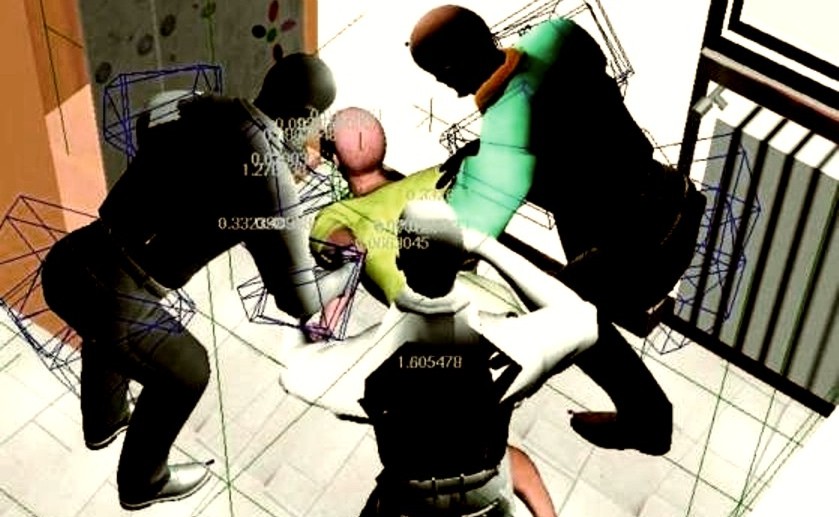
[Accurate Italian media recreation of attack based on masses of closed court evidence 2009]
Vital media history in 2009
In Italy and Europe generally the guilt of the two is almost universally perceived.
One reason is that although about 1/4 of the trial in 2009 was behind closed doors (quite the opposite of the “tabloid storm” and “show trial” Americans have been told about) Italians in particular got to find out about the long (15 minutes), remorseless, highly sadistic attack on Meredith.
Please click here for more
Wednesday, January 29, 2014
Continuing Enormous Strength Of The Evidence Which Defenses Seem To Have Abysmally Failed To Shake
Posted by Our Main Posters
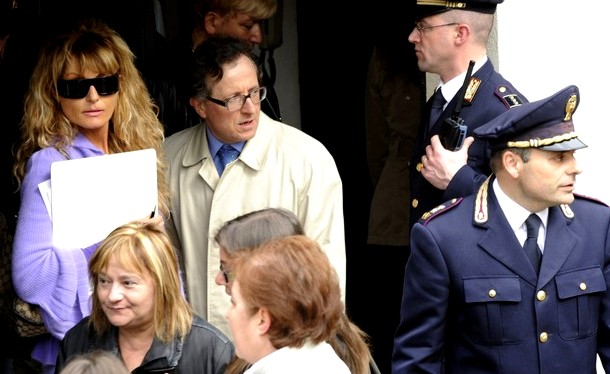
[Above Judge Massei at Meredith’s house with panel-of-judges members early 2009]
What this Florence appeal is REALLY about
There is much confusion on this, sowed by various at-distance commentators who don’t read the Italian press or the excellent English-language reporters right there on the spot.
This is NOT a re-trial. This is a FIRST appeal by Sollecito and Knox against the guilty verdicts and sentences Judge Massei awarded them late in 2009. It is being repeated since their defense teams helped to bend the first (Hellmann court) iteration of the first appeal two years ago.
Since the end of 2009 they have been provisionally guilty of murder and other crimes, subject to final ratification by the Supreme Court, which has not yet occurred. Judge Hellmann decided to let them out and travel worldwide. Many think his decision on this was legally weak.
Was there prime-face justification for this appeal?
Under US and UK law many lawyers and judges think the judicial process could have stopped right there in the US and UK, because the grounds for appeal the defenses came up with in 2010 were essentially innuendo about DNA and little else.
But the pro-defendant Italian system unlike almost any other in the world allows appeals if any are filed to automatically go forward. So the bent, stretched-out and illegally wide-scope Hellmann appeal of 2011 was the first result.
Appointed apparently in illegal circumstances to replace the highly-qualified Judge Chiari (the lead-judge for criminal appeals, who then resigned) Judge Hellmann was ill-qualified at best - he was not a criminal judge and had handled only one other murder trial before, which he got wrong.
The annulment of the first first-appeal
The Supreme Court very rarely completely annuls any trial or appeal. But in this case in March 2013 it did just that, on a large number of grounds.
The 2013-2014 Nencini appeal court in Florence starts with the early-2010 Massei report plus new guidelines from the Supreme Court. Nothing else floated since early 2010 counts.
This case seems to break all records ever for (1) defamatory and dishonest PR; (2) dirty tricks, many illegal, by the defense; (3) dishonesty by those accused in two defamatory books and multiple statements to the press; and (4) greed and blood money while the process still goes on.
Contempt of court trials and investigations have commenced to push back, Amanda Knox is particularly at risk because her book contains false accusations of crimes (again) and she defies the Supreme Court in not paying Mr Lumumba his damages though she destroyed his business.
Suggested Reading: Part One
Sooner or later (no necessarily now) read all the must-read posts in this group here, all the open questions for Sollecito in this group here, and all the open questions for Amanda Knox in this group here.
1. Getting up to speed on the 2008 RS and AK charges
Our four-part summary of Judge Micheli’s report is the best thing to read (scroll down) especially Micheli’s argument that ONLY Knox had any reason to re-arrange the crime scene - she lived there and needed to point evidence away from herself.
Also read Amanda Knox’s and Raffaele Sollecito’s many mutually contradictory attempts to provide one alibi for both.
2. Getting up to speed on the 2009 RS and AK trial
The prosecution performed brilliantly and left the defenses despondent and out-classed (paving the way for more dirty tricks in 2010-13) and we were told that two defense lawyers nearly walked off.
To get a flavor of how badly the defenses did, read this post and this post on Knox’s absolutely disastrous stint on the stand. From there the defense portion of the trial really went downhill.
To get a flavor of how well the prosecution did read about the damning reconstruction (known about in all of Italy but not widely elsewhere) described here and here.
3. Getting up to speed on the Massei 2010 Report
The most vital read of all is the short-form version of the Massei Report by Skeptical Bystander and a team on PMF dot Org. If you have no time to read any posts, make sure to read that.
The other vital reads, not here but on the new “The Murder Of Meredith Kercher Wiki”, are the overview of the evidence and the chart of evidence synopsis.
We had a large number of posts starting in 2010 checking out whether in all details the Massei Report got it right. Read this first take.
4. Getting up to speed on the crime-scene scenario
Vital to understanding the Massei court’s crime-scene scenario which Prosecutor Crini espouses, wade through this excellent reconstruction of the crime in a long Powerpoint by our lawyer James Raper with the Powerpoint whizz Kermit.
About Part Two
The next part of our most-recommended reading from 2010 to 2014 will follow after the verdict to help correct the ill-informed debate over whether Knox goes back to jail.
It hardens the case and in our view leaves no holes for RS and AK to wiggle through. We will point the post to those arguments that anyone tries to raise.
Thursday, January 09, 2014
Appeal Session #8: Sollecito Attorneys Today Try To Show Where Police And Prosecution Went Wrong
Posted by Our Main Posters
[Giulia Bongiorno today; previously she collapsed in court after a guilty verdict in PM Andreotti’s case]
4. Tweets by Main Poster Machiavelli
148. Bongiorno relies on her “personal belief” as last argument. Bye bye!
147. Bongiorno offers the known arguments to maintain an early time of death. But (now) it’s late for me.
146. She had opened her arguments by quoting Sardinian judge and author Salvatore Satta, to me the choice suggest setting a desperate defence
145. Bongiorno built and waded through a complex building of argument employing extreme rhetoric devices, seemed to be in difficulty to me.
144. I had the impression Nencini was skeptical because not interested in the photos and videos, did not look at them attentively.
143. Details the “plausibility” of an intrusion through the window. Glass shards etc. arguments already seen.
142. “Cogne” is a famous Supreme Court ruling saying guilt can be found “by logical exclusion” on sheer “a contrario” arguments.
141. After brandishing two knifes before the court, talking about footprint, makes an emphatic comment “We are not in Cogne”
140. Bongiorno has ended the ninja-knife-rotating phase.
139. Now Bongiorno speaks about the bathmat bloody print. Says Sollecito’s big toes do not balance on the dystal phalanx. (old argument)
138. Bongiorno shows a picture with an envisioned “knife” (pocket knife belonging to Guede?) together with the print on the bed sheet
137. Nobody brings a “small blow with a big knife”.
136. Says: to paint a large wall you need a “great” (big) brush (paraphrase of a pun from old advertisement) but you don’t use half of a big knife
135. Bongiorno handles a big knife!
134. My opinion: just behind the hyoid bone base there is the cervical vertebra, very resistant, it was the vertebra that offered resistence.
133. When there is a will to kill, the blade penetrates entirely.
132. Bongiorno dismisses the possibility that hyoid bone could have somehow stopped the blade, prevent from penetrating, it’s not resistant enough
131. cites the report by Dr. Umani Ronchi, saying the knife is compatible, but the blade was not used entirely.
130. Last point about the knife is the kind of blade: 17 cm long, while the wound is 8 cm deep. It’s too big, not the murder weapon.
129. Says there isn’t a note indicating a quantifying was done.
128. B: alleges “many mysteries” about Stefanoni’s report. Says there is no DNA amount.
127. In Stefanoni’s report it looks like as if for all knife DNA traces RealTime had been used; and it’s not true. SAL say Fluorimeter used
126. Another point: Fluorimeter. Stefanoni said the PCR method would have been better.
125. Question how he could deduce the knife was compatible. Bongiorno’s points seem extremely weak.
124. Bongiorno attacks on Finzi’s word: quotes testimony when says “It’s the first knife I noticed” and “seemed compatible with wounds”.
123. Question is: possible that Sollecito kills and then puts the knife back in the drawer again? and that he uses a knife from his own kitchen?
122. How is it possible to touch the clasp, but not the rest of the bra? Then Bongiorno says, now let’s deal with the knife.
121. B: There are two questions: 1. why no traces of Knox and Sollecito (except the clasp); 2. why Sollecito’s DNA on clasp but not on bra?
120. No trace of Knox, how could they clean only their own traces…. etc
119. Attributes to Guede the “rest of the whole bra” plus the purse and sweater traces.
118. Emphasizes that other objects in the room instead are “stuffed with” traces of Guede
117. Also, there is the Y chromosome sequence but says it is not reliable for the same reasons.
116. Mentions further reasons for criticism: 1 low template DNA 2 no second amplification (maybe confuses with knife) 3 unknown biological origin
115. Talks about the expert claiming the DNA profile could be compatible with herself (actually wrong, the expert was a female had no Y profile)
114. Says they “found Sollecito’s profile among a 4- individuals mixed trace”.
113. Says Stefanoni applied a suspect-cantered interpretation method on a mixed trace with multiple possibilities. Old argument, weak.
112. The profiles mixed in the trace are more than two, thus DNA not usable. This point of arguments perceived as weak in room.
111. Says the bra clasp trace is a mixed trace.
110. Says mixed DNA profiles are like overlapping of spider webs. High probability of mistake which thread belongs to which one
109. Bongiorno bashes “inconsistence” of Stefanoni and maintains she mistook stutters for alleles.
108. Says if we apply Stefanoni’s criteria to her own findings, the clasp X trace is not attributable to Sollecito
107. Points out the C&V report where they object how Stefanoni considered the peaks departing from guidelines. Say C&V analyzed each peak.
106. Asks, rhetorically, about the way how Stefanoni read the DNA profiles.
105. Mentions the presence of other DNA contributors on the bra clasp.
104. The usual magnified photo showing the dirt on police glove.
103. Calls these “touchings within a contaminated environment”.
102. Says clasp fabric was touched 14 times with one glove, then touched by other gloves.
101. Says the clasp was moved, found under the carpet, originally was under the pillow.
100. B. shows pictures about the object moved around in the room, carpet under table, cloths on bed etc.
99. Complains about the searches made by Napoleoni’s team on Nov 6 & 7 and objects Prosecutor Crini is wrong when says there was only one collection.
98. Says the bra clasp has a “materialization” on the night of Nov. 3 but was not collected because they forgot to place a tag letter.
97. Emphasizes that the forgotten bra clasp has become the pivotal piece of evidence against Sollecito.
96. Says about 20 people have manipulated objects on the crime scene.
95. Emphatically lists the names of all officers who entered the house.
94. Calls the DNA collection “mother of all mistakes” in this case.
93. Items should be touched only once. Stefanoni told the police to not move the items.
92. Disposable gloves must be used, new ones for each item. Quotes Intini saying impossible avoid contamination of crime scene.
91. Says the collection of DNA is fundamental. The collection must be early.
90. Says Cassazione didn’t read the C&V report carefully. Says not all DNA is usable. Stutter peaks should not be considered.
89. Now Bongiorno is talking about DNA.
88. Basically Bongiorno defined evidence against Sollecito as only three points: (1) late call to police (2) knife with Meredith DNA (3) shoe/foot print
87. When B was describing Donnino as a psychic there were people laughing in the room. Her arguments became more effective after the first hour
86. Bongiorno’s series of “half pieces of evidence” seemed like empty rhetoric. The use of video seemed somehow better.
85. The late clock theory is to maintain that Sollecito did not call the 112 after police arrival.
84. The defence theory is the clock was slow, not fast.
83. Bongiorno showed video of alleged Police arrival recorded by parking CCTV, explains defence theory.
82. One thing the SC and PG doesn’t know is about what she calls the “real” timing of Sollecito phone call to 112, as “proven” by defence.
81. One mistake at the Guede trial was about the shoe print attribution.
80. Explains that the subsequent trials of Guede got many facts wrong because they ignored subsequent development.
79. Said Cassazione did not assess the DNA judge appointed report and that testimonies and defence reports were missing.
78. Bongiorno explained the “reverse funnel effect” by which superior court is unaware about additional findings.
77. Sollecito - said B.- would not intervene to help a guy he didn’t know, and not even to protect Knox whom he had been knowing 9 days
76. If cleaning issues were a casus belli among the girls, why would Sollecito enter a raw to defend Rudy?
75. But B. objected this is still only half a motive, because Sollecito had nothing to do with it.
74. Apparently B. acknowledged Laura Masotho testified about problems with Knox cleaning habits. PG thinks means problems living together
73. Talked about the “second motive” calling it “improper use of toilet”
72. Said Guede was a drop-out, the opposite pro-black prejudice is also unacceptable.
71. Urged the court to not assume as individual is a weak and discriminated subject just because a black man
70. The sex theme party is “surreal” Bongiorno said.
69. Said Knox-Sollecito was a tender relation, they enjoyed romantic kisses, were not bored 50y old seeking hot emotions
68. The motive (sex) for the “festino” (little party) was smartly dropped by the PG
67. The motive “accepted” (by courts) was a sex party, but the PG does not believe it.
66. Said motive was considered almost as an optional; said prosecutor general changed the motive because had no choice.
65. Said that Kokomani was offered 10k euros for his testimony.
64. Bongiorno criticized media trials and said witnesses must be “virgins”, otherwise the Aladdin lamp taints the trial
63. Said the Aladdin lamp effect is generated by media trial, in which a “monster” is chased by public opinion
62. Bongiorno talked about “Aladdin lamp effect”: detectives wishes which materialize.
61. Said Mr. Kokomani “materialized” when investigators had desperate need to prove Sollecito and Guede knew each other
60. Bongiorno talked at length to substantiate a scenario of Rudy as a burglar who was used to knives.
59. Rudi would physically approach girls and try to kiss them when he was drunk, B. Said
58. Said Guede harassed girls and Sollecito did not know him.
57. Said when the investigators found Rudi, they could not abandon the first suspects, because it’s difficult like leaving your first love mate
56. Said there is no evidence the three people hung out together.
55. Spoke about Guede’s alleged lifestyle.
54. Said that was the nightmare of Perugia, the intruder nightmare.
53. Said the room is flooded with evidence of Guede all over the place.
52. Bongiorno criticized factual points addressed by Cassazione, mentions wrong early experts reports.
51. She described Knox as almost unconscious, buckled because she trusted Sollecito, thinks the police and Raff say so, must be true.
50. When Knox learns about bring accused by Sollecito she had a collapse while the “psychic” was saying “remember!”
49. Amanda, B. says, did not understand why Raffaele accused her.
48. Bongiorno urged judges to get out from codes and get into the hearts of the two young accused.
47. Said if you believe to the Memoriale, where does it mention Raffaele?
46. The recording of Knox’s conversation with her mother “proves she was still in delusional state”
45. Bongiorno said even if you believe her confession, she doesn’t mention Sollecito.
44. Said Amanda was “induced into raving” by “psychic” Donnino.
43. Explained the three types of false confessions.
42. Said Knox did not commit a crime but convinced herself she did. B. mentions the internalized false confession type.
41. Talked about police mistake on the “see you later” message
40. Said trial was determined by the fact Donnino fid not understand English well, thus sidetracked Knox
39. But, said, if we look at Knox, it’s not her sidetracking investigation, but rather investigators sidetracking her.
38. Said the Cassazione suggests Raffaele lied about timings of call to carabinieri, accused him of sidetracking because he lied.
37. One of the elements against Sollecito is the accusation of having sidetracked investigation. Said it was false.
36. Called Donnino a “medium” ( means .“psychic”)
35. Said Donnino acted as mediator not interpreter
34. Said Donnino altered Knox’s statements.
33. Bongiorno criticized interpreter Anna Donnino.
32. Sollecito’s aunts wiretapped as if they were the most dangerous murderers.
31. Talking about insults [to Sollecito’s family members], Bongiorno cries.
30. Says they also insulted Knox
29. Amanda was caught by anxious urge to answer. She became uncomfortable because police asked too much, altering her serenity
28. Bongiorno says if the court doesn’t want to read the whole interrogation (of Dec 17) they should at least read the memoriale
27. Nencini interrupts Bongiorno: how could I read all interrogations entirely, when Supreme Court prevents me from doing so?
26. Calunnia doesn’t mean there is evidence of murder.
25. Only half of the house of murder investigated. An interrogation considered evidence of Knox’s calunnia.
24. Says Raffaele was “halfed”, against him only half pieces of circum evidence: half shoeprint’ knife compatible only if you consider half of blade
23. [My] Impression that Bongiorno’s start of defence speech was rather weak. Too much over the top, reveals weakness.
22. shoeprint attributed in advance because boyfriend of Amanda. Speaks about “admission” by Rinaldi-Boemis
21. She is tired of Raffaele reduced by “half”, a half character seen as a reflection of Amanda
20. Says Knox was the main character, she was so before the trial.
19. Speaks about “creativity” before the trial. Speaks at length about the bloody shoeprint.
18. Bongiorno: Raf thinks he was put in jail because of wrong print. But not true: it’s because he was Amanda’s boyfriend.
17. Shows pictures of Vinci’s analysis of pillowcase prints.
16. Bongiorno also said other reason for suspicion was that Knox had the keys. The motive chosen was “ideal” not real.
15. Most active and free women are seen as more suspicious.
14. Bongiorno: women are suspected because of today women’s empowerment movements.
13. Started from a sex party gone awry theory. They asked themselves: who could take part to such party? A 20y American sexy girl.
12. Investigators followed Lombrosian criteria (inspired by Cesar Lombroso theories)
11. Says: it was Perugia population who chose the less disquieting scenario, and the investigation was based on “less alarming motive” choice
10. Bongiorno: authority had to chose between a “tranquillizing” student motive and a dangerous serial killer “worrying” scenario.
9. Why did they accuse and put them in jail so early? They didn’t even have the knife.
8. Complains Sollecito doesn’t find a job because has a murderer’s face
7. Bongiorno focuses on the “early bias” against accused, since four days after finding of body.
6. Bongiorno speech hinges around the persecution of defendants. Describes her fear, fleeing from Perugia. Says people didn’t know trial papers
5. Bongiorno was shocked by the angry mob before Perugia courtroom [after Hellmann verdict]
4. Bongiorno: a bloodthirsty mob chasing defendants
3. Reads book snippet about French revolution, describe a horde of sanculots and armed citizens
2. Bongiorno quotes Italian author Satta. Talks about “chase” of the two accused
1. Sollecito is in courtroom
3. Tweets By Freelance Andrea Vogt
15. Leaving court, raffaele sollecito and father expressed satisfaction w/closing args. Perugia attorny Maori to close at next hearing, Jan.20.
14. Bongiorno closing finish: Turn amanda off. Acquit them both, but judge Raffaele Sollecito for who he is, not for half-truths against him.
13. A loud emergency evacuation request was just broadcast in Florence court, but the presiding judge says hearing will continue.
12. Once you’ve seen Bongiorno wave two knives in front of an Italian jury, most other court reporting one has done seems rather dull.
11. Bongiorno holds up butcher knife like the one in evidence to jury: “This knife is too big. It is not the murder weapon.”
10. New amanda knox court schedule: [prosecution] rebuttals Jan 20, with verdict on Jan 30.
9. Florence amanda knox appeal: court breaks until 14:15. Unclear if sollecito defense will finish today or spill over.
8. Bongiorno: Sollecito is not a puppy dog. He may have brushed her hair, cleaned her ears, but he would not kill for love of amanda knox.
7. Bongiorno and judge exchange laughs over “unca nunca” the eskimo kiss. “I’m over 50,” he said “I need an explainer.”
6. Bongiorno on witnesses found by local journos: “This trial had an Aladdin’s Lamp. Every time cops needed a witness, one materialized.”
5. Bongiorno defending Amanda Knox, while at the same time clearly separating Sollecito’s position from that of Knox.
4. Bongiorno reading amanda’s statement: “If you believe this is a confession, where’s Raffaele? He is never, never, never mentioned.”
3. Bongiorno just read wiretapped comms of Perugia cops Napoleoni and Zugarini insulting Sollecito’s family.
2. Bongiorno: “Amanda amanda amanda amanda amanda . . . And raffaele? Basta with sollecito always being considered Knox’s other half.”
1. Bongiorno: Perugia declared “case closed” 4 days after Kercher murder, w/no murder weapon and a motive intended to calm public fear.
2. Tweets by La Nazione Court Reporter
66. Bongiorno: “In conclusion Amanda and Raffaele are innocent “
65. Bongiorno: “I am convinced that the murderess is Rudy who has already been convicted “
64. Bongiorno “The attack on Meredith takes place at 21.10 when Raffaele ‘s at home “
63. Bongiorno: “Guede had already entered into three more apartments in the holiday periods “
62. Warning to evacuate the court. But it is only a test
61. Bongiorno: “Is it possible that the glass has been broken from the outside “
60. Bongiorno: “The absence of traces of mud on the wall is because in those days it was not raining”
59. Bongiorno: “Plausible hypothesis that someone has entered the window “
58. Bongiorno: “You can not get to a liability via just exclusion . We are not in Cogne “
57. Bongiorno: “Against Sollecito, no real clue “
56. Bongiorno: “The footprint on the rug is not Sollecito, his foot does not match “
55. Bongiorno: “The murder weapon is a boxcutter knife with 8 inches “
54. Bongiorno: “The knife found at Sollecito’s house is not the murder weapon “
53. Bongiorno: “Depth wounds on the victim is not compatible with the size knife “
52. Bongiorno addresses the issue of the knife
51. Bongiorno: “Absurd to think that Amanda and Raffaele have deleted only their tracks
50. Bongiorno: “How can you think that there is only a trace of Sollecito on the clasp ? “
49. Bongiorno: “On the scene of the crime no trace of Amanda, but only Rudy Guede “
48. Bongiorno: “On the hook there are traces of four profiles of DNA “
47. Bongiorno: “That hook looks like it was taken from a landfill “
46. Bongiorno: “The hook was crushed during the inspections “
45. Bongiorno: “The bra clasp was moved “
44. Bongiorno: “The hook of the bra is not at the first inspection reperted “
43. Bongiorno: “About 20 people came to the house between the two surveys
42. Bongiorno: “The finding attributed to Sollecito jumps out only in the second survey “
41. Bongiorno: “It is not true that no one came on the scene between the two surveys “
40. Bongiorno addresses the issue of DNA on the bra clasp of the victim
39. After the break the summation of lawyer Giulia Bongiorno starts again.
38. The hearing is adjourned for an hour
37. Bongiorno ( Sollecito defense ) : ” Rudy Guede did not want to respond to our defense [at Hellmann appeal] “
36. Bongiorno ( Sollecito defense ) : “No survey has ever spoken of the presence of more subjects [than one]”
35. Bongiorno ( Sollecito’s defense ) : “It was Raffaele who raised the alarm”
34. Bongiorno ( Sollecito’s defense ) : “And we demonstrated that Sollicito called 112 before the police arrived “33. Bongiorno ( Sollecito’s defense ) : ” If the motive are disputes on the hygiene of the house, where was Raffaele ? “
32. Bongiorno ( Sollecito’s defense ) : ” The indictment identifies the changes to driving and excessive use of water”
31. Bongiorno ( Sollecito’s defense ) : “the relationship of Amanda with Raffaele was tender, kissed like Eskimos “
30. Bongiorno ( Sollecito’s defense ) : ” Guede unwelcome, if there had been a party he would not have asked “
29. Bongiorno ( Sollecito’s defense ) : ” In this process, the motive is considered an option, but it is not “
28. Bongiorno ( Sollecito’s defense ) : ” Absurd to think that Sollecito and Guede became known that night “
27. Bongiorno ( Sollecito’s defense ) : ” The witness who spoke of the friendship between Raffaele and Rudy Guede was denied “
26. Bongiorno ( Sollecito’s defense ) : ” Amanda Raffaele prosecuted even when they told [the truth?] “
25. Bongiorno ( Sollecito ) : ” Absurd Amanda putting herself at the scene of the crime”
24. Bongiorno ( Sollecito’s defense ) : ” Amanda never pulled into the dance Raffaele “
23. Bongiorno ( Sollecito’s defense ) : ” Amanda wassidetracked , it is she who is derailed “
22. According to the lawyer Bongiorno interpreter on night of interrogation of Amanda did not just translate
21. Bongiorno ( Sollecito’s defense ) : ” The interpreter admiited to having helped in the court”
20. Bongiorno ( Sollecito ) : ” The interpreter confirms that she has done so in trial court as mediums in the interrogation “
19. Bongiorno ( Sollecito ) : ” Amanda says that the interpreter invited her to remember”
18. Bongiorno ( Sollecito ) : “There are black pages in this investigation “
17. Bongiorno ( Sollecito ) : ” According to the documents offenses of aunts of Sollecito by those who listened to the wiretaps “
16. Bongiorno ( Sollecito ) : ” Amanda and nighttime interrogations without a lawyer “
15. Bongiorno ( Sollecito ) : ” The identikit identfication of the killer as Amanda proceded and generates slander “
14. Bongiorno ( Sollecito ) : “On the footprints attributed to Sollecito there was a big mistake “
13, Bongiorno ( Sollecito ) shows some slides in the court on the footprints at the crime scene
12. Bongiorno ( Sollecito ) : ” Raffaele is not the only other half of Amanda . Just a quick passion “
11. Bongiorno ( Sollecito ) : ” Amanda was the stronger of the pair with Sollecito “
10. Bongiorno ( Sollecito ) : ” Amanda was leading [the two] before becoming involved in the legal process”
9. Bongiorno : ” Starting from the motive of the game , Amanda seemed like the perfect one guilty “
8. Bongiorno ( Sollecito ) : ” They have chosen an ideal motive and then followed the criteria Lombroso “
7. Bongiorno ( Sollecito ) : ” A creation was the motive to reduce fear in Perugia , a party gone wrong “
6. Bongiorno ( Sollecito’s defense ) : ” In record time, the case was declared closed almost immediately , after four days ‘
5. Bongiorno ( Sollecito ) : “Against Amanda and Raffaele horde of red herrings”
4. Bongiorno ( Sollecito ) : “Sollecito was branded a murderess when there was no evidence “
3. Bongiorno ( Sollecito ) : ” Raffaele and Amanda have become the symbol of depravity ‘
2. Start of the argument of the lawyer Giulia Bongiorno , Sollecito’s defense
1. Start of the hearing. Today it’s up to the lawyers Raffaele Sollecito
1. Overview post Wednesday by Andrea Vogt
Website of Andrea Vogt
Defense lawyers Giulia Bongiorno and Luca Maori will give closing arguments on behalf of Raffaele Sollecito Thursday in Florence, starting at 10 a.m.While Amanda Knox has been the main focus of attention for most of the U.S. media covering this case, Sollecito has increasingly become the object of gossip in the Italian press, with tabloid magazines like Oggi regularly publishing snaps of him on vacation this winter in Santo Domingo.
More recently several local newspapers in Veneto published speculation about a new woman friend and fellow University of Verona student with whom he had been hanging out with over the holidays in a small town near Treviso. Amore or amica? He’s not about to tell.
At his last spontaneous declaration before the court Sollecito complained about his lack of privacy and pleaded with the jury to give him his life back. Tomorrow his lawyers will make the case for his innocence formally to the judge and jury. Expect fireworks from Bongiorno, famous for her captivating oratory and no stranger to high-profile cases “” having cut her teeth as defense lawyer for former Italian prime minister Giulio Andreotti.
ol
Tuesday, December 17, 2013
Appeal Session #7: The Day For Knox And Sollecito Attorneys To Show Where Prosecution Went Wrong
Posted by Our Main Posters
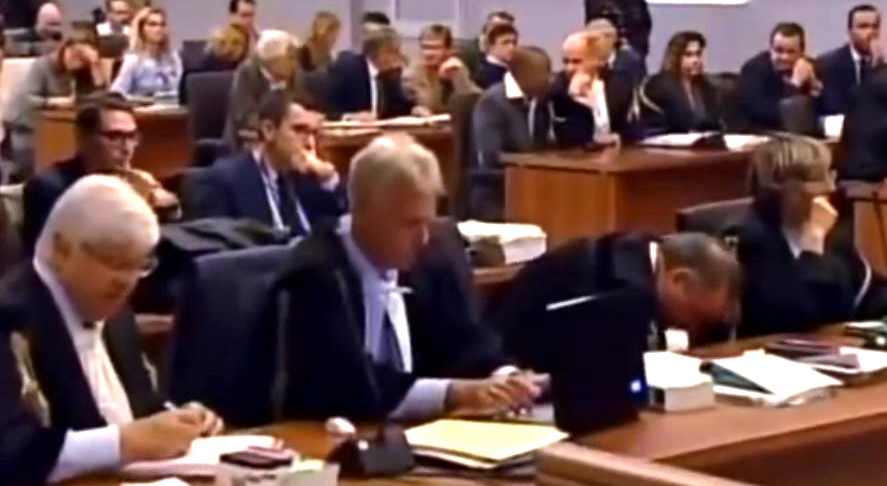
[Above and below: images from previous sessions, here till today’s crop appears]
Long Form Reports
The court hearing reserved for Knox’s appeal defense began with the reading of an email from Amanda, reported here in the Messaggero and then widely picked up in the English-language press, claiming her innocence and explaining why she was afraid to return to Italy. The email was the only “new” aspect introduced Tuesday so made all the headlines, but at the end of the day it occupied just a small fraction of the day’s arguments.
Several Italian court observers considered the email a considerable “own goal,” having witnessed the presiding judge raise his eyebrows in obvious annoyance at having to himself read aloud an email from Knox, who requested an appeal in his courtroom, but is refusing to attend it, for reasons she detailed. “Those who want to speak at the trial should come to the trial,” he said. He also declined to consider the letter a spontaneous declaration because, he said, he could not ascertain if she was the true author of the letter. “I’ve never seen her. I do not know her,” he said.
After the email, Knox’s Perugian lawyer Luciano Ghirga made his closing arguments, followed by Carlo Dalla Vedova of Rome. Most of the discussion focused on two aspects of the case they felt are fundamentally lacking: motive and murder weapon. Below are short quotes/snippets translated quickly during court. To read the Kercher family lawyer’s arguments, scroll down to yesterday’s notes.
[Report continues on The Freelance Desk with good summaries of arguments made by Ghirga and Della Vedova]
3. Tweets from La Nazione
66. Meredith process , the hearing ends. The next hearing will be on January 9 [Sollecito team]
65. Lawyer Dalla Vedova (Knox) : ” Amanda Knox is shown to have worshipped [Meredith]”
64. Lawyer Dalla Vedova (Knox) : “There is a shortage of proof”
63. Lawyer Dalla Vedova (Knox) : “There is no evidence, with doubts you have to acquit Amanda Knox”
62. Lawyer Dalla Vedova (Knox) : “On the motive the prosecutor did the same as the Costa Concordia at Giglio”
61. Lawyer Dalla Vedova (Knox) : “Room too small for the participation of more people in the crime”
60. Lawyer Dalla Vedova (Knox) : “The victim was attacked from the front, not from behind”
59. Lawyer Dalla Vedova (Knox) : “For Amanda and Raffaele, Rudy Guede was a stranger”
58. Lawyer Dalla Vedova (Knox) : “The bra clasp of Meredith is not a genuine artifact”
57. Lawyer Dalla Vedova (Knox) : “The bra clasp November 2nd was white, but 40 days after gray”
56. Lawyer Dalla Vedova (Knox) : “Amanda knew the cut was throat because she was told by a policeman “
55. Lawyer Dalla Vedova (Knox) : “Absurd that there are missing only traces of Amanda and Raffaele “
54.Lawyer Dalla Vedova (Knox) : “The alleged footprint of female shoe on the pillow: pillowcase was folded over.”
53. Lawyer Dalla Vedova (Knox) : “The broken glass from the window shows the easiest way to enter the house “
52. Lawyer Dalla Vedova (Knox) : “War between consultants is like “The War of the Roses” where everyone will hate “
51. Lawyer Dalla Vedova (Knox) : “Unable for Amanda and Raffaele to commit the crime in 50 minutes “
50. Lawyer Dalla Vedova (Knox) : “The mother of Meredith says she and Amanda were friends “
49. Lawyer Dalla Vedova (Knox) : “Guede never says that Amanda was in the house, even outside the interrogations”
48. Lawyer Dalla Vedova (Knox) : “Guede never talks about Amanda “
47.Lawyer Dalla Vedova (Knox) : ” Guede in his chats after the murder told a friend that Amanda had nothing to do with it”
46. Lawyer Dalla Vedova (Knox) : “There are traces only of Rudy Guede at the crime scene “
45. Lawyer Dalla Vedova (Knox) : “The witness Curatolo either is unreliable or is our alibi. Decide for yourself “
44. Lawyer Dalla Vedova (Knox) : “Do not trust the testimony of the witness Quintavalle “
43. Lawyer Dalla Vedova (Knox): “Amanda did not call into question Lumumba to sidetrack the investigation “
42. Lawyer Dalla Vedova (Knox): “The alibi of Amanda is of the same type as her roommates ”
41. Lawyer Dalla Vedova (Knox): “The alibi of Amanda is accurate and unchanged in her deposition ”
40. Meredith appeal: the argument of Carlo Dalla Vedova, defender of Amanda Knox, resumes.
39. Meredith appeal: Judge orders one-hour lunch break
38. President Nencini asks if there are certificates for the AIDS tests done on Amanda, but there are none
37. Lawyer Dalla Vedova (Knox): “It was said of Amanda in prison that she had AIDS, but it turned out an error ”
36. Lawyer Dalla Vedova (Knox): “From the conversations in prison Amanda does not show anything, the sum of zeros ”
35. Lawyer Dalla Vedova (Knox): “In 30 hours of interviews with parents in prison Amanda never was heard [incriminating herself]”
34. Lawyer Dalla Vedova (Knox): “It was immediately admited, the mistake by the investigators”
33. Lawyer Dalla Vedova (Knox): “The footprint of Guede on the pillow right now is the signature of the crime”
32. Lawyer Dalla Vedova (Knox): “Lumumba was not to be charged, he confirmed his alibi”.
31. Lawyer Dalla Vedova (Knox): “There has been judicial harassment against [my client]”
30. Lawyer Dalla Vedova (Knox): “Prosecution and plaintiff leverage statements of Amanda unusable ”
29. Lawyer Dalla Vedova (Knox): “The declarations of Amanda between 5 and 6 November are unusable ”
28. Lawyer Dalla Vedova (Knox): “Absurd that Amanda is joining the attack on a friend ”
27. Lawyer Dalla Vedova (Knox): “Changing motive is constantly an element of weakness of the prosecution ”
26. Lawyer Dalla Vedova: “Add up all the clues , the sum of zero is always zero ”
25. Lawyer Dalla Vedova: “Without connections between clues and evidences the value is zero ”
24. Lawyer Dalla Vedova: “In this process there is no evidence ”
23. Lawyer Dalla Vedova: “A murder without a motive is fallacious ”
22. Lawyer Dalla Vedova: “Absurd that the knife used for the murder was brought home ”
21. Lawyer Dalla Vedova: “Imaginative reconstruction of the prosecution ”
20. Lawyer Dalla Vedova: “This story has been in the headlines for months ”
19. Lawyer Dalla Vedova (Knox): “Meredith killed in this manner is a defeat for all ”
18. The closing argument of Lawyer Carlo Dalla Vedova begins (Knox defense).
17. Meredith appeal: the closing argument of the Lawyer Ghirga (Knox ) ends.
16. Lawyer Ghirga (Knox ) : “Amanda Knox was not present at the crime scene ”
15. Lawyer Ghirga (Knox ): “The judgment of Justice is the acquittal of Amanda
14. Lawyer Ghirga (Knox ): “The witness Curatolo is unreliable ”
13. Lawyer Ghirga (Knox ): “We challenged from the outset the murder weapon ”
12. Lawyer Ghirga (Knox ): “On the blade of the knife there is no blood and no trace of Meredith.”
11. Lawyer Ghirga (Knox ): “The expertise that revealed traces of Meredith on the knife is not trusted “
10. Lawyer Ghirga (Knox ): “The knife found at Sollecito’s house is not the murder weapon “
9. The closing argument of Luciano Ghirga defender Amanda Knox begins.
8. Amanda to the court: ” I am innocent , put an end to this enormous injustice ”
7. Amanda : “I’m not the monster he has been portrayed in recent years ”
6. Amanda: ” I did not know Rudy Guede ”
5. Amanda: “I’m not a killer , the prosecution and the civil parties are wrong , they want a conviction without proof ”
4. Amanda: ” Meredith and I have always been friends , we never quarreled ”
3. Amanda: “I have been subjected to illegal interrogation , I made a false confession extorted”
2. Amanda: “I have not killed , raped , robbed , I was not at the scene of the crime”
1. The email of Amanda : “I’m innocent , but I am not in court because I’m afraid”
2. Tweets from Freelance Andrea Vogt
3. Carlo dalla Vedova to #amandaknox appeal jury: If there is no murder motive, you must acquit.
2. Carlo dalla Vedova: We know #amandaknox is innocent. As time passes we’re even more tranquil.There are many more doubts than certainties.
1. In Florence, amanda knox lawyer holds up large knife to jury: “Starch was on the knife. It was not cleaned. It was in domestic use.”
1. Email from Amanda Knox
Court of Appeals of Florence section II Assise Proc. Pen, 11113
Letter sent to attorneys Carlo Dalla Vedova and Luciano Ghirga via email Seattle, 15 December 2013
Attn: Honorable Court of Appeals of Florence
I have no doubt that my lawyers have explained and demonstrated the important facts of this case that prove my innocence and discredit the unjustified accusations of the prosecution and civil parties. I seek not to supplant their work; rather, because I am not present to take part in this current phase of the judicial process, I feel compelled to share my own perspective as a six—year-long defendant and victim of injustice.
The Court has access to my previous declarations and I trust will review them before coming to a verdict. I must repeat: I am innocent.
I am not a murderer. I am not a rapist. I am not a thief or a plotter or an instigator. I did not kill Meredith or take part in her murder or have any prior or special knowledge of what occurred that night. I was not there and had nothing to do with it.
I am not present in the courtroom because I am afraid. I am afraid that the prosecution’s vehemence will leave an impression on you, that their smoke and mirrors will blind you. I’m afraid of the universal problem of wrongful conviction. This is not for lack of faith in your powers of discernment, but because the prosecution has succeeded before in convincing a perfectly sound court of concerned and discerning adults to convict innocent people-Rafael and me.
My life being on the line and having with others already suffered too much, I’ve attentively followed this process and gleaned the following facts that have emerged from the development of this case that I beg you not to dismiss when making your judgment:
No physical evidence places me in Meredith ‘s bedroom, the scene of the crime, because I was not there and didn’t take part in the crime.
Meredith’s murderer left ample evidence of his presence in the brutal scenario: handprints, footprints, shoe prints in Meredith’s blood; DNA in her purse, on her clothing, in her body.
No evidence places me in the same brutal scenario. The prosecution has failed to explain how I could have participated in the aggression and murder—to have been the one to fatally wound Meredith—without leaving any genetic trace of myself. That is because it is impossible. It is impossible to identify and destroy all genetic traces of myself in a crime
scene and retain all genetic traces of another individual. Either I was there, or I wasn’t. The analysis of the crime scene answers this question: I wasn’t there.
My interrogation was illegal and produced a false “confession” that demonstrated my non-knowledge of the crime- The subsequent memoriali, for which I was wrongfully found guilty of slander, did not further accuse but rather recanted that false “confession.” Just as I testified to the prosecutor in prison and to my family members in prison when our conversations were being recorded without my knowledge.
My behavior after the discovery of the murder indicates my innocence. I did not flee Italy when I had the chance. I stayed in Perugia and was at the police’s beck and call for over 50hours in four days, convinced that I could help them find the murderer. I never thought or imagined that they would have used my openness and trust to fuel their suspicions. I did not hide myself or my feelings: when I needed comfort, Rafael embraced me; when I was sad and scared, I cried; when I was angry, I swore and made insensitive remarks; when I was shocked, I paced or sat in silence; when I was trying to help, I answered questions, consoled Meredith’s friends and tried to keep a positive attitude.
Upon entering the questura I had no understanding of my legal position. Twenty—years old and alone in a foreign country, I was innocent and never expected to be suspected and subjugated to torture. I was interrogated as a suspect, but told I was a witness. I was questioned for a prolonged period in the middle of the night and in Italian, a language I barely knew. I was denied legal counsel- The Court of Cassation deemed the interrogation and the statements produced from it illegal. I was lied to, yelled at, threatened, slapped twice on the back of the head. I was told I had witnessed the murder and was suffering from amnesia. I was told that if I didn’t succeed in remembering what happened to Meredith that night I would never see my family again. I was browbeaten into confusion and despair. When you berate, intimidate, lie to, threaten, confuse, and coerce someone in believing they are wrong, you are not going to find the truth.
The police coerced me into signing a false “confession” that was without sense and should never have been considered a legitimate investigative lead. In this fragmentary and confused statement the police identified Patrick Lumumba as the murderer because we had exchanged text messages, the meaning of which the police wrongfully interpreted (‘Civediamo piu tardi. Buona serata’). The statement lacked a clear sequence of events, corroboration with any physical evidence, and fundamental information like: how and why the murder took place, if anyone else was present or involved, what happened afterward—it supplied partial, contradictory information and as the investigators would discover a little later, when Patrick Lumumba’s defense lawyer produced proof of him incontestable alibi, it was obviously inaccurate and unreliable. I simply didn’t know what they were demanding me to know. After over 50 hours of questioning over four days, I was mentally exhausted and I was confused.
This coerced and illegitimate statement was used by the police to arrest and detain a clearly innocent man with an iron-clad alibi with whom I had a friendly professional relationship. This coerced and illegitimate statement was used to convict me of slander. The prosecution and civil parties would have you believe that this coerced and illegitimate statement is proof of my involvement in the murder. They are accusing and blaming me, a result of their own overreaching.
Experience, case studies, and the law recognize that one may be coerced into giving a false"confession” because of torture.
This is a universal problem. According to the National Registry of Exoneration, in the United States 78% of wrongful murder convictions that are eventually overturned because of exonerating forensic evidence involved false “confessions.” Almost 8 in 10 wrongfully convicted persons were coerced by police into implicating themselves and others in murder. I am not alone. And exonerating forensic evidence is often as simple as no trace of the wrongfully convicted person at the scene of the crime, but rather the genetic and forensic traces of a different guilty party—just like every piece of forensic evidence identifies not me, but Rudy Guide.
In the brief time Meredith and I were roommates and friends we never fought.
Meredith was my friend. She was kind to me, helpful, generous, fun. She never criticized me. She never gave me so much as a dirty look.
But the prosecution claims that a rift was created between Meredith and I because of cleanliness. This is a distortion of the facts. Please refer to the testimonies of my housemaster and Meredith’s British friends. None of them ever witnessed or heard about Meredith and I fighting, arguing, disliking each other. None of them ever claimed Meredith was a confrontational clean-freak, or I a confrontational slob. Laura Masotho testified that both Meredith and I only occasionally cleaned, whereas she and Filomena Romanelli were more concerned with cleanliness. Meredith’s British friends testified that Meredith had once told them that she felt a little uncomfortable about finding the right words to kindly talk tome, her new roommate, about cleanliness in the bathroom we shared. The prosecution would have you believe this is motivation for murder. But this is a terrifying distortion of the facts.
I did not carry around Rafael’s kitchen knife.This claim by the prosecution, crucial to their theory, is uncorroborated by any physical evidence or witness testimony. I didn’t fear the streets of Perugia and didn’t need to carry around with me a large, cumbersome weapon which would have ripped my cloth book bag to shreds. My book bag showed no signs of having carried a bloody weapon. The claim that he would have insisted I carry a large chef’s knife is not just senseless, but a disturbing indication of how willing the prosecution is to defy objectivity and reason in order to sustain a mistaken and disproven theory.
It is yet another piece of invented “evidence”, another circumstance of theory fabricated to order, because having discovered nothing else, the prosecution could only invent.
I had no Contact with Rudy Guide.
Like many youth in Perugia, I had once crossed paths with Rudy Guide. He played basketball with the young men who lived in the apartment below us. Meredith and I had been introduced to him together. Perhaps I had seen him amongst the swarms of students
who crowded the Perugian streets and pubs in the evenings, but that was it. We didn’t have each other’s phone number, we didn’t meet in private, we weren’t acquaintances. I never bought drugs from Rudy Guide or anyone else. The phone records show no connection. There are no witnesses who place us together. The prosecution claims I convinced Rudy Guide to commit rape and murder, completely ignoring the fact that we didn’t even speak the same language. Once again, the prosecution is relying upon a disturbing and unacceptable pattern of distortion of the objective evidence.
I am not a psychopath.
There is no short list to the malicious and unfounded slanders I have suffered over the course of this legal process. In trial I have been called no less than:
“Conniving; manipulating; man—eater; narcissist; enchantress; duplicitous; adulterer; drug addict; an explosive mix of drugs, sex, and alcohol; dirty; witch; murderer; slanderer; demon; depraved; imposter; promiscuous; succubus; evil; dead inside; pervert; dissolute; a wolf in sheep’s clothing; rapist; thief; reeking of sex; Judas; she-devil;
I have never demonstrated anti-social, aggressive, violent, or behavior. I am not addicted to sex or drugs. Upon my arrest I was tested for drugs and the results were negative. I am not a split-personality One does not adopt behavior spontaneously.
This is a fantasy. This is uncorroborated by any objective evidence or testimony. The prosecution and civil parties created and pursued this character assassination because they have nothing else to show you. They have neither proof, nor logic, nor the facts on their side. They only have their slanders against me, their personal opinions about me. They want you to think I’m a monster because it is easy to condemn a monster. It is easy to dismiss a monster’s defense as deception. But the prosecution and civil parties are both severely mistaken and wrong. They have condemned me without proof of guilt, and they seek to convince you to condemn me without proof of guilt.
If the prosecution truly had a case against me, there would be no need for these theatrics. There would be no need for smoke and mirrors to distract you from the lack of physical evidence against me. But because no evidence exists that proves my guilt, the prosecution would seek to deceive you with these impassioned, but completely inaccurate and unjustified pronouncements. Because I am not a murderer, they would seek to mislead you into convicting me by charging your emotions, by painting me not as an innocent until proven guilty, but as a monster.
The prosecution and civil parties are committing injustices against me because they cannot bring themselves to admit, even to themselves, that they’ve made a terrible mistake.
The Court has seen that the prosecution and civil parties will not hear criticism of their mistakes. Not by the experts of the defense, nor by the experts of the Court.
The Court has seen that the prosecution jumped to conclusions at the very start of their investigation: they interrogated and arrested innocent people and claimed “Case Closed"before any evidence could be analyzed, before bothering to check alibis.
The prosecutor and investigators were under tremendous pressure to solve the mystery of what happened to Meredith as soon as possible. The local and International media was breathing down the necks of these detectives. Their reputations and careers were to be made or broken. In their haste, they made mistakes. Under pressure, they admitted to as few mistakes as possible and committed themselves to a theory founded upon mistakes.
Had they not jumped to conclusions based on nothing but their personal and highly subjective feeling, they would have discovered definitive and undeniable evidence of not Patrick Lumumba, not Rafael Sollecito, not Amanda Knox, but of Rudy Guide. We would not be here over six years later debating inconclusive and unreliable “clues.” We would have been spared the cost, anguish and suffering, not only of Raffaele’s and my family, but especially of Meredith’s family as well.
The prosecution’s accusations are unworthy of judicial or public confidence. In over six years they have failed to provide a consistent, evidence-driven, corroborated theory of the crime, but would nevertheless argue that you should take my life away. I beg you to see the facts and reason of what I say. I am innocent. Rafael is innocent. Meredith and her family deserve the truth. Please put an end to this great and prolonged injustice.
in faith,
Amanda Marie Knox
Monday, December 16, 2013
Appeal Session #6: Case For Knox’s & Sollecito’s Guilt - The Civil Parties
Posted by Our Main Posters

[Above, today: Dr Maresca, the Florence lawyer who speaks for the victim, arrives at the court]
7. Court resumes tomorrow
Court will resume at 9:30 am Italy time with the first of the summations for the defenses. When they conclude, probably in January, the prosecution will have a chance of rebuttal.
6. Reporting in English
Andrea Vogt has posted a detailed report from the court at The Freelance Desk, Scroll down to the heading “Update Dec 1t 2013”
5. Reporting in Italian #3
Amanda Knox and Raffaele Sollecito, accused in the murder of British student Meredith Kercher, were in the grip of a “murderous rage” fuelled by illegal drugs and alcohol, a lawyer for the victim’s family said Monday. Knox, Sollecito and a third person definitively convicted of the crime, Rudy Guede, had “no inhibitions” because of the drugs and alcohol they ingested before murdering Kercher in November 2007, charged Vieri Fabiani.
Only later did the “fear take over” and led to false explanations including a simulated break-in and robbery, and a false accusation against a bar owner in Perugia, where the murder occurred, added Fabiani. A Florence court is trying the case against Knox and Sollecito, who have been on trial twice before for the murder of Kercher. Both have said they are not guilty of the accusations.
Guede was convicted in a fast-track trial and is serving a 16-year sentence in the murder, but Italy’s top appeal court said it was unlikely he acted alone. Knox, who is in the United States and has not returned for this trial, and Sollecito each served two years in prison after a lower court convicted them of murder in 2009. An appeal court overturned those convictions in 2011 and in March, Italy’s highest court sent the case back to the appeals stage over aspects of the evidence it argued had not been properly examined before.
The supreme court ruled that the initial forensic evidence had been wrongly dismissed in the acquittal and a prosecution theory about a sex game that went wrong should be re-examined. Kercher, 21, was found dead on the floor of an apartment she shared with Knox on November 2, 2007. Guede’s DNA was found inside Kercher, on her clothes, and elsewhere in the apartment.
Fabiani said that a motive for the murder was “irrelevant” because the crime was committed while the trio were abusing substances. An Italian prosecutor has requested a 26-year prison term for Knox and Sollecito for the murder, plus a further four years for Knox for allegedly slandering bar owner Patrick Lumumba, whom she initially implicated during tough police questioning before later retracting, saying she had been confused.
The new trial opened in Florence in September, and a decision is expected on January 10.
Translation by The 411
4. Reporting in Italian #2
For the Kercher family it is “intolerable” that Amanda Knox on her website is issuing “invitations to collect donations in memory of Meredith” declared Dr Francesco Maresca, the lawyer for the parents and siblings of Mez, speaking in the Assize Court of Appeal of Florence, where judicial process continues for the murder of the young British student Meredith Kercher, which occurred in Perugia on the night of November 1, 2007 .
Dr Maresca asked the Court “to forget the opposing sides and all that is foreign to the process”, meaning the media coverage of the controversy being generated in the U.S. in the legal defense of Knox, as they should also “forget the statements made in court a few weeks ago by Raffaele Sollecito, who is now returned to a “vacation” in Santo Domingo”
Dr Maresca also pointed the finger at Knox for her book, for which she signed “contracts in the millions” and also retains “a person to handle public relations”. Finally, he invited the Court to also forget “those journalists who are inspired by the freedom of delirium and not the freedom of the press.”
Many elements confirm the original verdict. “We have no doubts about the guilt of the accused - there are so many elements to confirm the sentence”.
The family of Meredith Kercher, said the lawyer, will be in Florence on the day of the judgment of the appeal for the murder of the young British student by the defendants Amanda Knox and Raffaele Sollecito .
This was a heinous crime committed knowingly. “We ask the Court for truth and justice for a heinous crime committed with precise awareness and desire” said the lawyer Vieri Fabiani, one of the lawyers of the Kercher family… “The defendants Amanda Knox and Raffaele Sollecito and Rudy Guede, in the process of killing Meredith Kercher, were “excited and a murderous rage was triggered” because, with the drugs and alcohol taken ” their minds were free of inhibitions”.
Fabiani focused in particular on Rudy Guede also convicted for the murder of Meredith, recalling that the judgment was delivered after the first degree trial in Perugia [in October 2008]. And on the verdict against Guede, Fabiani stated that he was sentenced in collusion with another two who “accidentally” have been identified as Sollecito and Knox, whose responsibility and presence on the scene of the crime are well documented.
Fabiani called Sollecito and Knox persons of “high criminal capacity” who have created the picture of a crime without serious motive. Then after the murder “fear, terror, took over and they set out to simulate a theft, frame Patrick Lumumba, to mystify, however clumsily, to banish from their minds the crime they committed.”
Fabiani argued that the presence of two defendants in the house on Via della Pergola that evening, and their willingness toward murder, were strongly demonstrated.
“The motive becomes irrelevant,” even if it can be identified “in the issues between Amanda and Meredith, which evolved into a sort of punishment of the victim, in an escalation”.
3. Reporting in Italian #1
Amanda Knox, Raffaele Sollecito and Rudy Guede were ” excitedly and this unleashed their homicidal rage ” that tragic night between the first and November 2 of 2007. Vieri Fabiani, one of the lawyers of the Kercher family, during the appeal session in Florence about the murder of Meredith Kercher .
Because of drugs and alcohol their minds were “devoid of inhibitions ,” argued the lawyer, according to whom the defendants should be considered ” persons of a high criminal capacity .” After the murder, fear took over, then they get to simulate a theft, to accuse Lumumba, to mystify to banish from their minds the crime they committed.”
The lawyer explained that the presence of the two defendants at the crime scene and their willingness to commit murder was strongly demonstrated. “The motive becomes almost irrelevant, even though important elements can be identified” in the problems existing between Amanda and Meredith, which “evolved into a sort of punishment of the victim in an escalation”.
For the Kercher family it is “intolerable that Amanda Knox on her website makes invitations to collect donations in memory of Meredith” added the lawyer Maresca. He invited the Court ” to forget the opposing sides and all that is foreign to the process.” The court should “forget” the statements made in court a few weeks ago by ” Raffaele Sollecito who has returned to “a vacation” in Santo Domingo
Avv Maresca also pointed the finger at Amanda and her book thanks to which she ” has signed contracts making her a millionaire.”
2. Tweets from La Nazione
10. Amanda knows the mode of the crime because she was present
9. Motive is irrelevant, the presence of the accused at the scene of the crime is proven
8. Amanda and Raffaele in the grip of the excitement and this triggered the murderous rage
7. It is not sustainable that Rudy Guede is the only murderer
6. The lack of motive is irrelevant, there is evidence of homicidal intent
5. The ruling of the Supreme Court crushed the acquittal of appeal
4. Amanda knew the mode of the murder
3. On the knife found at Sollecito’s house there was the DNA of the victim
2. Contamination of the bra clasp is false (invented)
1. Meredith proceedings: hearing begins. Lawyer Vieri Adriani for the victim family to speak first
1. Tweets from Freelance Andrea Vogt
5. Courtroom nearly empty for closing args of lawyer representing meredith kercher family. Not much interest in their quiet suffering.
4. Maresca: “While we’re here in trial, Sollecito in Santo Domingo & Knox in US taking online donations for victim she’s accused of killing.”
3. Kercher attny Serena Perna: Meredith’s many wounds in many places (from bare hands,from knife, yet not defensive) = multiple attackers.
2. Kercher attny: Motive, or lack thereof, is absolutely irrelevant.1000 different problems could have led to fatal escalation of violence.
1. Right now lawyers for the civil parties (specifically Kercher family) giving closing arguments. Defense is to follow.
[Below: two images in the courtroom from previous sessions]
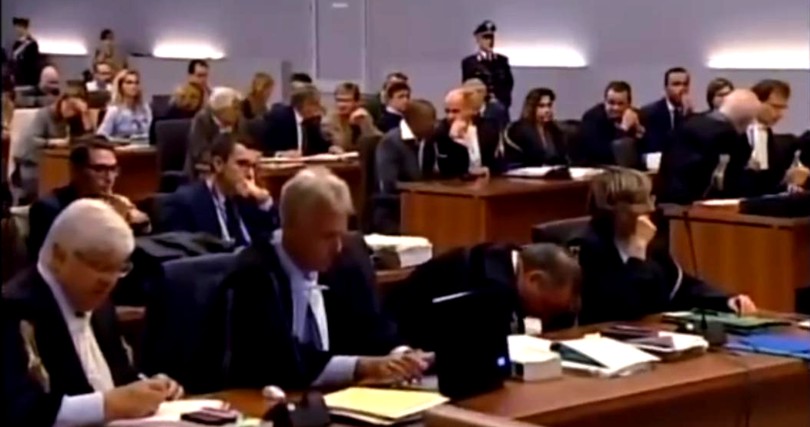
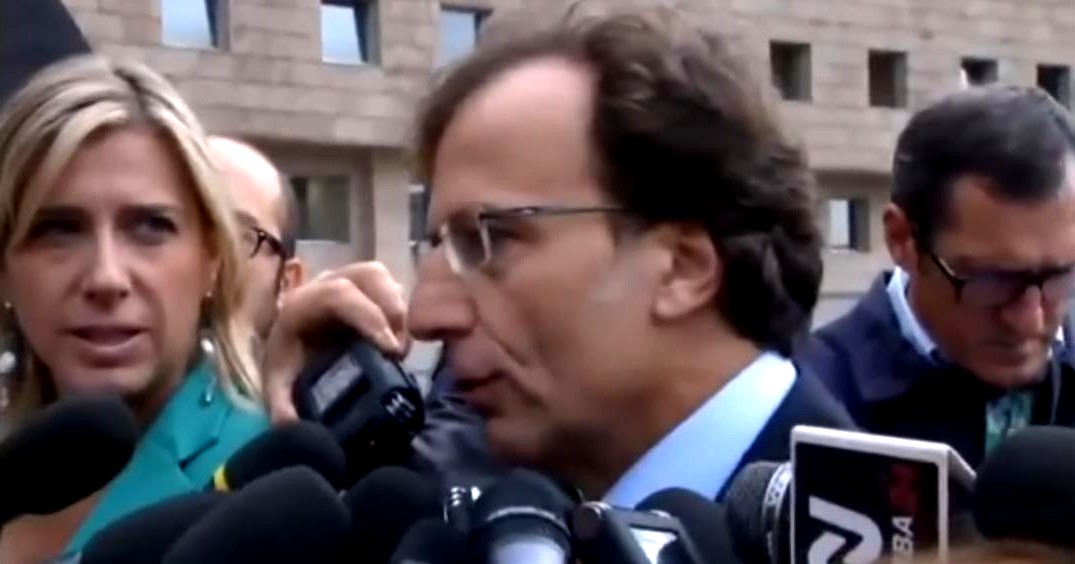
Friday, September 27, 2013
Questions For Sollecito: Why So Many Contradictory Explanations Of How DNA Got On The Knife?
Posted by SomeAlibi
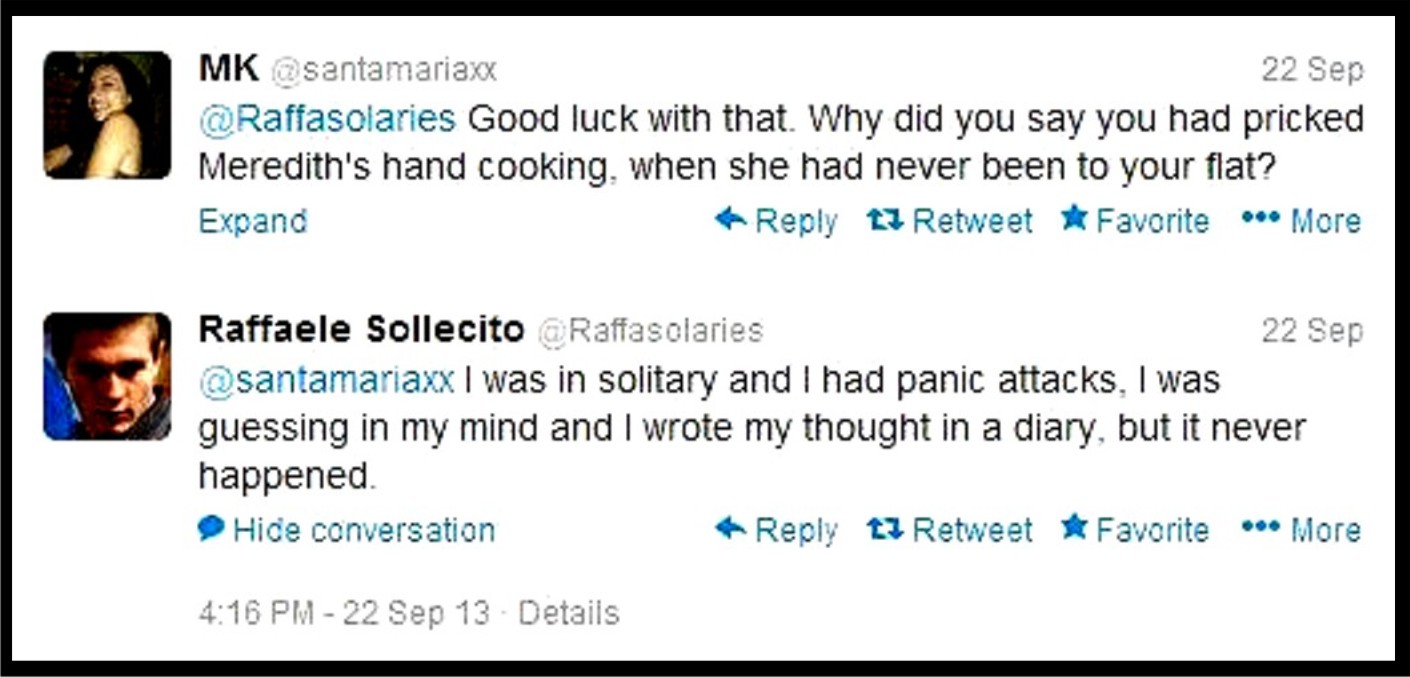
It is no secret (except seemingly to him) that Sollecito’s book and web postings will once again land him in court.
This trial will be separate from the main appeal though the prosecution office will be the same. It will be for alleged contempt of the court in serially mis-stating the evidence and accusing many officials of crimes in an attempt to get public opinion to lean heavily on the courts.
The Amanda Knox brigade has been trying that too, and look at how well that is working out!
Here is one seemingly perfect example of how Sollecito (finally responding to the pressures and pleas of his discombobulated lawyers?) may be trying to wind things back. You will recall that news of the discovery of a large knife in his kitchen drawer with Meredith’s DNA on it was related to Sollecito while he was in his prison cell, just over two weeks after the murder.
As much as the news initially panicked him, shortly thereafter on November 18th, 2007, he seemed relieved to have realised how Meredith’s DNA could have come to be on his kitchen knife after a session of, in his written words, “thinking and remembering”. He wrote in his diary:
The fact that there is Meredithʹs DNA on the kitchen knife is because on one occasion, while we were cooking together, I, while moving around at home {and} handling the knife, pricked her hand, and I apologized at once but she was not hurt {lei non si era fatta niente}. So the only real explanation for that kitchen knife is this one.
And that was it: Raffaele had “fortunately” remembered how he had “pricked” Meredith’s hand and that explained the DNA. He remembered it in precise detail - thank heavens for that!
The problem for Raffaele was that he didn’t know at this stage that the DNA was in a microscopic groove on the blade and not on the tip. The story made no sense. Worse, he was also flatly contradicted by the flatmates, the friends and even Amanda: he had never been cooking with Meredith and his story was therefore impossible as well as implausible. And since he was a murder suspect, the memories and all their specificity which would have given him an alibi for the DNA, became highly suspicious.
Unfortunately, Raffaele chose to remain silent thereafter and never testified, as was his right, at his trials.
Subsequently there were many months of Team Knox-Sollecito denying that Raffaele meant Meredith, in contradiction of all plain logic when reading the simple words in his diary. No, said the online apologists, in fact he meant Amanda’s hand and in some way he had thought that maybe Meredith’s DNA had been on Amanda and could have transferred. It wasn’t his fault that his theory was wrong, it was just an honest memory of being with Amanda and nothing suspicious at all.
On Twitter on September 22nd, Raffaele decided, probably unwittingly as is his wont, to blow that theory up. He was asked about the diary entry by Twitter user MK @santamariaxx and responded thus:
He replied as in the image above.
So, he didn’t really mean Amanda at all (thank-you for all the wasted hours of excuse making for Raffaele to those protagonists of that particular theory), but now we learn it was a false memory about Meredith that never happened.
But let’s unpick this because it’s far from a single mis-remembered sentence or action. This was a contemporaneous diary entry made barely two or three weeks after such a cooking event could have happened and it was a multi-faceted event with multiple actions. He was clear and precise about what happened in detail. Now, he is quite clear the whole thing never happened:
- 1. He said he was cooking together with Meredith - but that never happened
2. He recalled himself “moving about” during the cooking session - but that never happened
3. He remembered the location “at home” - but was never there in this context
4. He remembered putting a knife that he was holding into / onto Meredith’s hand - but that never happened
5. He remembered actively apologizing to Meredith for that clumsy act - but that never happened
6. He remembered the act of them examining Meredith’s hand and mutually discovering that she had not been hurt - but that never happened
7. He remembered that this was the real explanation of the kitchen knife - but it never happened
Sollecito was on his own in a cell, not under interrogation, and spending time “thinking and remembering” on November 18th. What he remembered, in detail, was a multi-part sequence of events with a girl who had been murdered barely two weeks before. He remembered the minutiae of what happened and its sequence when he believed he needed to provide an alibi for the identification of the DNA on his knife.
None of Amanda Knox’s vagueness about these memories - they were particular and specific in the finest detail. So fine and specific that when he was caught out that this could not have happened, those details looked highly like someone seeking to convince precisely because of the particularity of the details. It was in the time-honoured form: “no, no - it definitely happened, because I specifically remember”..... 7 distinct and separate memories and the sequence in which they occured.
But all those things never happened according to Raffaele Sollecito in 2013.
Knox and Sollecito have never stopped the self-serving lies and flat contradictions of themselves. Not now, even after all this time, even after one them is permanently stained as, at a minimum, a convicted liar who criminally tried to frame a man for murder. Sollecito, “not hiding” in his secret location, can’t stop either. Little good it will do either of them. Finally, justice is coming and the lies will be at end. I’d almost feel sorry for him, if he wasn’t then and remains now, an inveterate liar without the honour to face justice in the country of his birth.
Wednesday, July 03, 2013
Questions For Sollecito: Did Your Father & Lawyers Pre-Approve This Rant?
Posted by Our Main Posters
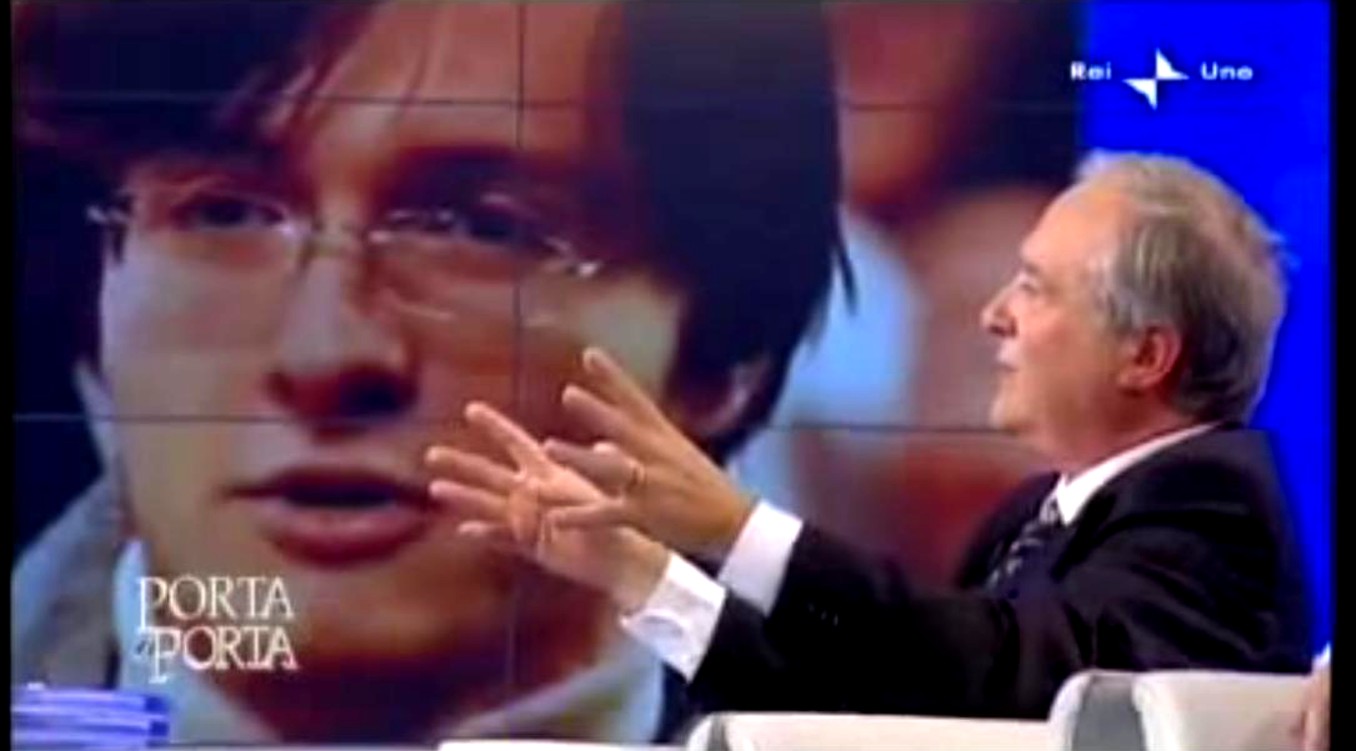
[Francesco Sollecito previously on Italian national TV trying to explain the weirdness of his son]
This is in response to your open letter to Italy’s TGCom website.
You are starting to sound eerily like the serial killer Ted Bundy in jubilant “catch me if you can” mode. Ted Bundy also thought he was the brightest guy on the block and the cops, prosecutors and judges were all a few bricks short of a wall.
Ted Bundy was of course caught, by smart cops, and put on trial, by smart prosecutors in front of a smart judge and jury. He made a terrible hash of his defence, he was unanimously found guilty, by a jury of smart peers, and he was made to pay his dues to society and the victims’ families - with his life.
You posted this to an audience in Italy which for the most part thoroughly dislikes you, when you are already in line for sentences that could cost you 30 years ranging up to life.
So. Did your father Francesco and your lawyers Bongiorno and Maori (and all of Knox’s people) give you the go-ahead for this seriously bizarre rant, or not?
Once upon a time, there was Amanda and Raffaele, she was an American student, studying languages and he studying Computer Science. They met at a classical concert and fell in love… no wait like that it is too boring….Lets make it more intriguing, lets see…..I know!
The prosecution found a crazy drunk, and cocaine dealer, Kokomani, after a year the story becomes: Amanda and Raffaele met in August, no one knows how or when, and one day at a bar, where Kokomani would get drunk, Amanda’s uncle came from America, no one knows why or when, and introduces the fiancees ( about to get married, I would say at this point) to the ignorant (unknown) Kokmani (who maybe thought he was going to be the best man) it’s clear. UNDERLINING that he is Amanda’s uncle and the two young people are Amanda and Raffaele (famous at the time, after all)
Mmmm…...come on it’s not the best, but at least it is more interesting, it doesn’t matter that there is no confirmation to none of this, anyway it’s a movie, OK. let’ s continue…..
Raffaele rents a house on Corso Garibaldi, a five minute walk from Via della Pergola, where Amanda lives with three roommates, Meredith, Filomena and Laura. The two pass many days together, they cuddle, have fun, they have outings to towns close to Perugia, and a couple of times they have lunch at Amanda’s house with the other flatmates. They live enthusiastic days, smiling every time they look in each others eyes….. Halloween Day, Oct. 31 2007, Amanda goes to work at Patrick Lumumba’s pub, so Raffaele works on his thesis and late that night they meet up….. to be together as always, taking care of each other.
Uff! What a pain in the ass! Give this movie a bit of adrenaline, what the hell! O.K. O.K…...one day along comes a heroin addicted serial super witness brought by the prosecution who says that he saw Amanda and Raffaele in Piazza Grimana, by a small villa a few feet from via della Pergola, discussing vividly, no one knows what and no one knows what day, but it happened at 9:00p.m. to 11:00p.m. circa. It doesn’t matter that the night between the end of Oct. and beginning of Nov. was freezing cold, it doesn’t matter that Raffaele has a house where he can do what the hell he wants, but according to the heroin addicted serial super witness, the two were under the rain for three hours (if we are talking about Nov. 1, 2007) and the cold discussing who knows what, furthermore, the heroin addicted serial super witness of murders (who’s name is Curatolo) says that when he went back to Piazza Grimana the two contentious fiancees were no longer there and he saw the buses that go to the discos boarding the kids…..it doesn’t matter that the 1st of Nov. there is not a bus in this world because the night at the disco was on the night of Halloween, Oct.31, 2007…...for the Pubblico Ministero Giuliano Mignini, Curatolo was a credible witness. Even because heroin does not produce hallucinations while cannabis does.
In reality the two fiancees passed the evening and the night at Raffaeles’s house since it was free and they had an intensive week of commitments. The 1st of Nov. in particularly Amanda had to work at Patrick’s pub, but as the evening was not busy he did not need Amanda, and after a friend of Raffaele’s passed by to cancel an appointment to go to the bus station, suddenly the two fiancees had the night free and they passed the time watching the movie “il favoloso mondo di Ameliè”, then eating fish Amanda read Harry Potter in German to Raffaele and they made love all night…...
Il Giudice di Primo Grado, Giancarlo Massei took in full the version of the heroin addicted serial super witness tramp….. Come on Giancarlo we are still not satisfied! Come on! These two fiancees are cramming our balls!! You are all of us….
According to the reconstruction of Judge Giancarlo Massei, that sentenced Amanda and Raffaele to 25 and 26 years in prison, things went this way: Amanda and Raffaele after being 3 hours in the cold under the rain, the night of the 1st of November 2007, head toward Amanda’s house in Pergola street and go right away into Amanda’s room (a room that was smaller than Raffaele’s cell when he was in prison) and start making love to bother Meredith who was reading a book in the other room…doesn’t matter that more than 5 people had car trouble and were waiting for a tow-truck, in front of the house during that time, and they give testimony that nobody passed by
Sorry, but why didn’t Amanda and Raffaele go to Raffaele’s house that was free and nobody would have been bothered?.. . Come-on! Why do you have to take into consideration this useless details, show us some firecrackers! Go Giancarlo!
Judge Massei continues: sometime during the evening, while the two were having sex in Amanda’s room, suddenly somebody knocked at the door… Amanda and gets up and gets dressed goes to the door and who does she see? ...Rudy Guede, a colored guy that didn’t know anybody except the guys of the lower floor and had met Amanda and Meredith one time but never in his life had he met Raffaele,. that urgently needed to take a shit.
But what?! What kind of plot is this? Where in the hell do you see that people go around knocking on doors because they need to take a shit?... Come on Giancarlo do not disappoint us! But judge Massei does not disappoint us…. Meanwhile Amanda opens the door to the poor black, victim of bewitched charm for Amanda, and goes inside to go to take a shit…. and Amanda as if nothing happen, goes back in the room and gets undressed again…
But why couldn’t Meredith go open the door while she was reading a book?..Oh, right! Otherwise Amanda loose the part of the main actress, sorry, you are right!
Practically , according to Judge Giancarlo Massei’s reconstruction the story goes on like this : while Amanda and Raffaele went back to have sex, Rudy Guede comes out of the bathroom, after listening to some songs on his ipod, he is overwhelmed by the SEXUAL VIBRATIONS that Amanda and Raffaele were relishing in the house hallway and the house room….
WTF Giancarlo, this is tough shit! Not even Dario Argento could come up with something like that…. “SEXUAL VIBRATIONS”....WTF you are a genius!! Give me five!...but the good part has still to come: when Guedé smells the SEXUAL VIBRATIONS, all of a sudden he is possessed and decides by all means that he has to have sexual intercourse with Meredith.. and ventures in her room and, being rejected, because poor soul he is ugly, Raffaele and Amanda get into the action and at that point dont help Meredith who is their friend, but, to the contrary and unexpectedly, they help Rudy Guede to rape Meredith and than finish her up cutting her throat…
All three had knives: Rudy has a past as thief, he used to burglarize offices and apartments with the same “modus operandi” that he used to get in in via della Pergola, moreover he has been captured while sleeping in a kindergarten in Milano with a knife in his bag. Raffaele had always a little collector knife in his pocket: never mind that he never used it to hurt anybody in his life, there are no traces of anybody else on his little knife “¦.Amanda… and Amanda? Judge Massei says that she used an enormous kitchen knife got from the “looser” Raffaele’s house and put it in her purse…. why?? because…YOU NEVER KNOW (a 15 cm knife can be always useful “¦).. Massei says.
But the poor Meredith was a small build girl, her wounds are not that big and that knife would have gone through the neck because of how big it is… there isn’t blood on that knife nor Meredith’s DNA because the analysis of the scientific police are completely unreliable , not having being compelled to observe the international protocols. There are no bleach traces. What the police says are hypothesis never proved .
Come on, details! But there are no traces of Amanda and Raffaele on the crime scene, there are only Guede’s, everywhere. How it is possible that they were cleaned, were are the traces of the cleaning??! Come on do not break our nuts! This is just details, let me see this movie!
What about that little bra hook? There are 5 different profiles…all on the iron part of the hook, nothing on the tissue: it has been found 46 days after the “polizia scientifica” swept the crime scene, and meanwhile even the police swept the scene with no anti-contamination precautions and put upside down the all apartment. There isn’t Raffaele profile on that hook: if that mix of traces is properly read you can find anybody’s DNA
Do you want to stop with these bothersome things?!! Lets finish to see this movie!! Massei concludes: we don’t know why Amanda and Raffaele choose to kill Meredith, but we have to accept their choice. THE EVIL CHOICE. Probably under the influence, because they didn’t despise her, taking into account that they said that they smoked a joint… unfortunately nobody tested to check if Amanda and Raffaele used heavy drugs or were in the habit of binge drinking. WTF! Great job! You weld The Exorcist and Lethal Weapon!! Giancarlo you are my idol!!!!

